Japanese bedroom design represents a harmonious blend of minimalism, natural materials, and tranquil aesthetics that transform your sleeping space into a peaceful sanctuary. Drawing from centuries-old traditions, these design principles emphasize simplicity, functionality, and a deep connection with nature. Whether you're seeking complete transformation or subtle touches, Japanese-inspired bedrooms offer timeless elegance through clean lines, neutral palettes, and thoughtfully curated elements. From traditional tatami mats and shoji screens to modern Japandi interpretations, these designs promote restful sleep and mental clarity. The philosophy centers on creating uncluttered spaces that encourage mindfulness and relaxation through carefully selected natural materials, soft lighting, and purposeful placement of essential items.
1. Japanese Bedroom Design with Traditional Tatami Mat Flooring
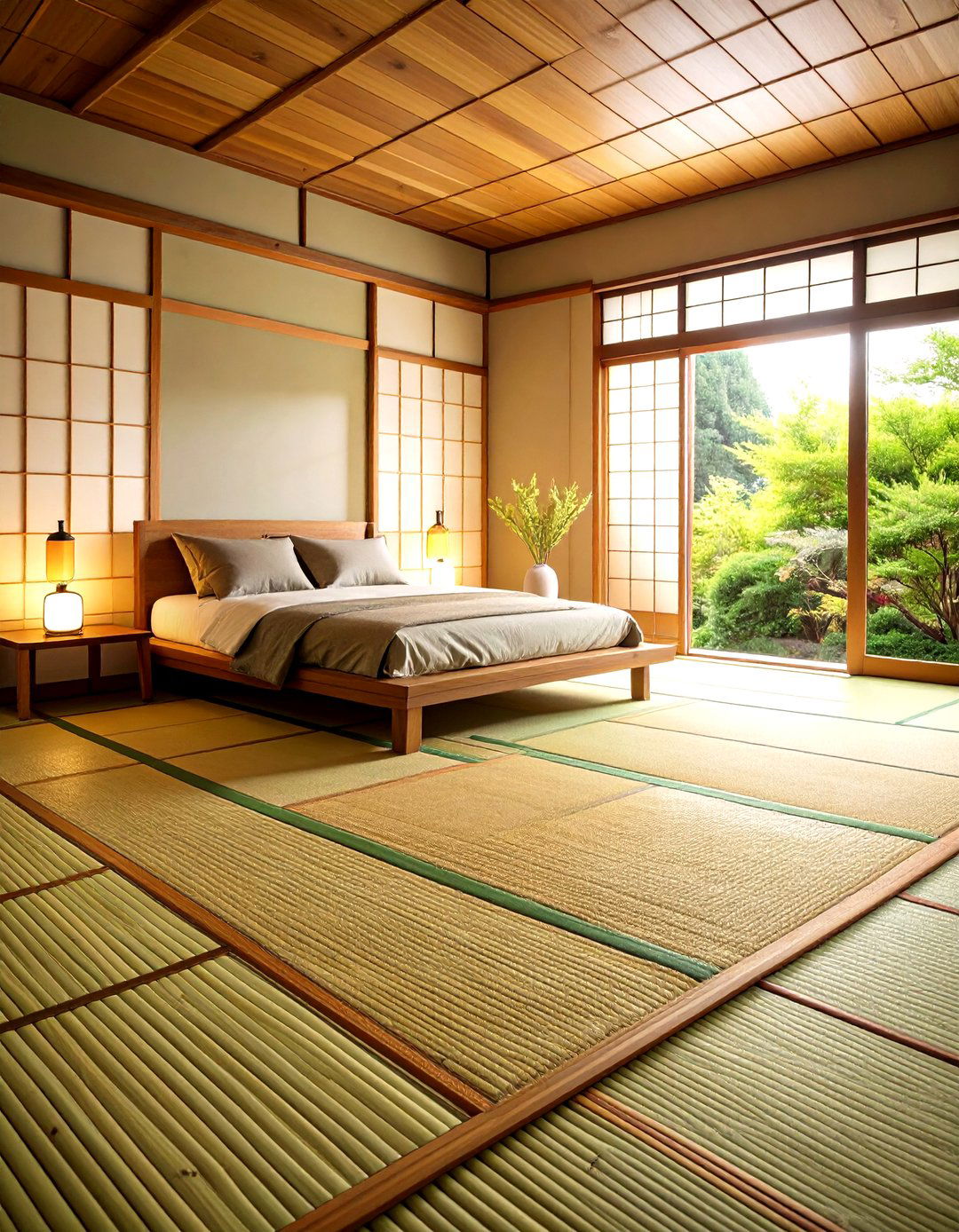
Authentic tatami mats create the foundation for traditional Japanese bedroom design, offering a natural sleeping surface that connects you directly with centuries-old customs. These mats are made from compressed rice straw and woven rush grass, providing firm support while maintaining breathability and natural insulation properties. The rectangular mats can cover your entire floor or specific areas, creating designated zones within larger bedrooms. Tatami mats are 100% compressed straw and come in various sizes to fit American mattress dimensions. Their golden-green color naturally ages to warm yellow tones, adding character over time. When paired with a thin futon mattress, this setup promotes better posture and spinal alignment. The natural materials emit a fresh, earthy aroma that enhances the room's calming atmosphere, making this an ideal choice for those seeking authentic Japanese sleeping traditions.
2. Japanese Bedroom Design Featuring Low Platform Bed Frames
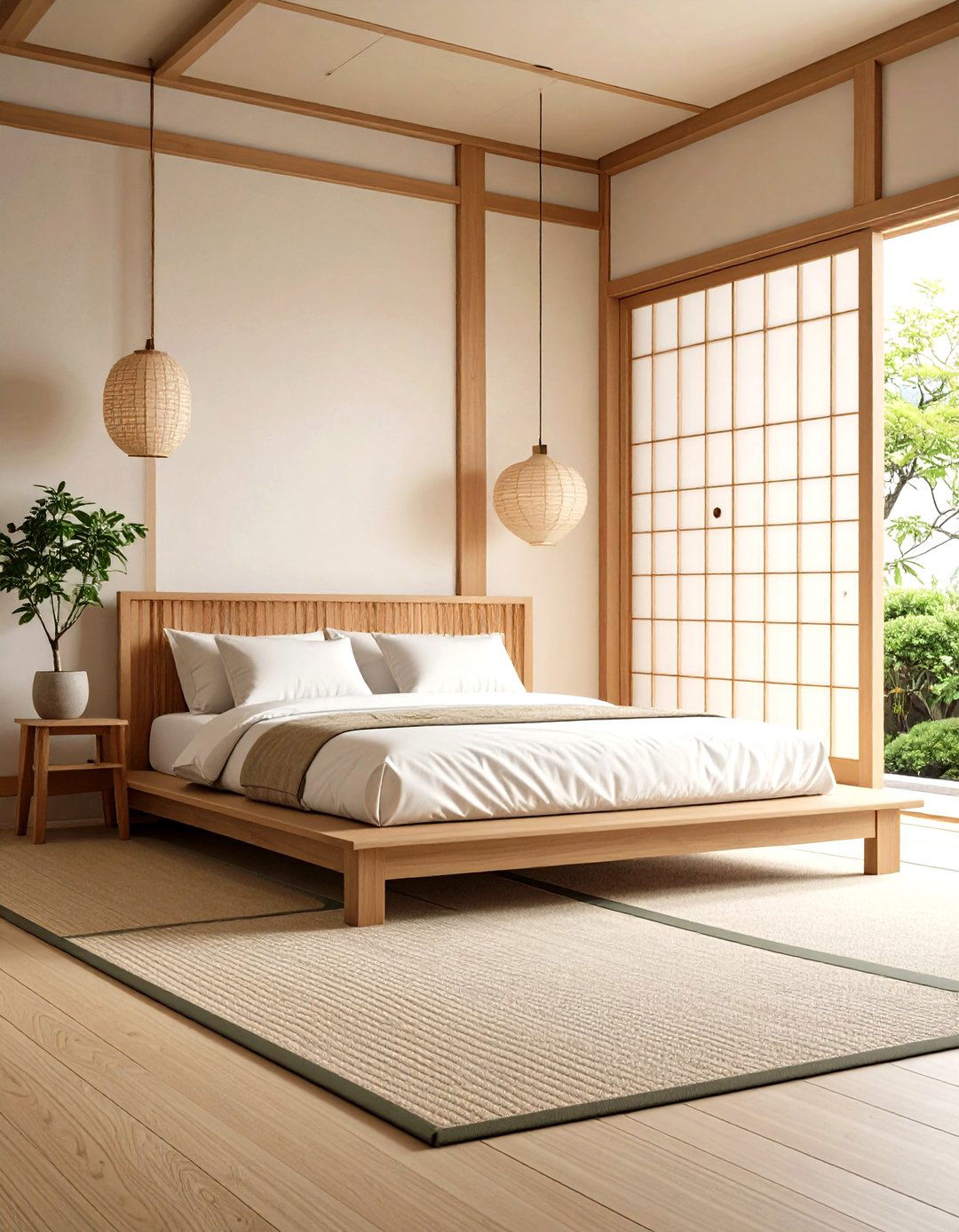
Consider a low platform bed frame to achieve the grounded, peaceful aesthetic central to Japanese bedroom design philosophy. These beds feature a flat surface where tatami mats are placed, supporting a futon mattress for sleeping, with the low profile promoting a clutter-free space. The elevated yet minimal height maintains connection with the floor while providing practical benefits like under-bed storage. Made from sturdy and sustainable materials such as bamboo and hardwood, these frames provide comfortable sleeping surfaces without needing box springs. Platform beds typically feature clean geometric lines and natural wood finishes that complement other Japanese design elements. Built-in drawers often accompany these frames, maintaining the minimalist aesthetic while offering hidden storage solutions. This furniture choice effectively anchors your room's design while supporting the Japanese principle of functional beauty in every element.
3. Japanese Bedroom Design with Authentic Shoji Screen Room Dividers
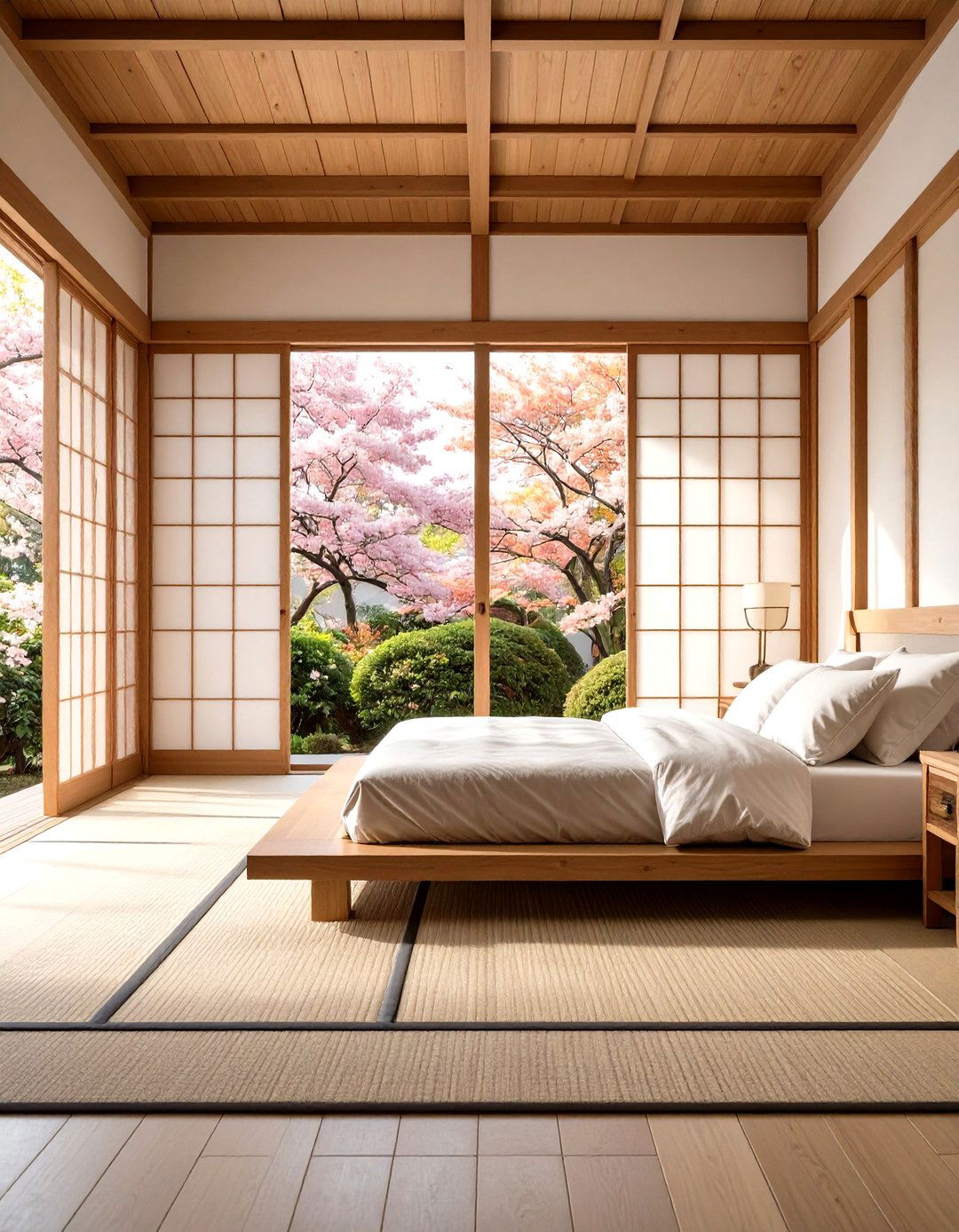
Transform your space using traditional shoji screens, which bring privacy and soft light filtration to Japanese bedroom design arrangements. These sliding doors serve as doors, windows, and room dividers, featuring rice paper panels in wooden frames that allow diffused light while maintaining privacy. Hand-built from solid wood and rice paper with traditional mortise and tenon joints, these screens were designed with beauty and durability in mind. The translucent panels create gentle shadows and warm lighting throughout the day, eliminating harsh artificial illumination. Modern versions may incorporate frosted glass or reinforced paper for increased durability. Whether used as room dividers, closet doors, or window coverings, shoji screens maintain the open, airy feeling essential to Japanese aesthetics. Their versatility allows you to reconfigure spaces easily while preserving the minimalist principles that define authentic Japanese bedroom design.
4. Japanese Bedroom Design Using Natural Bamboo Elements and Accents
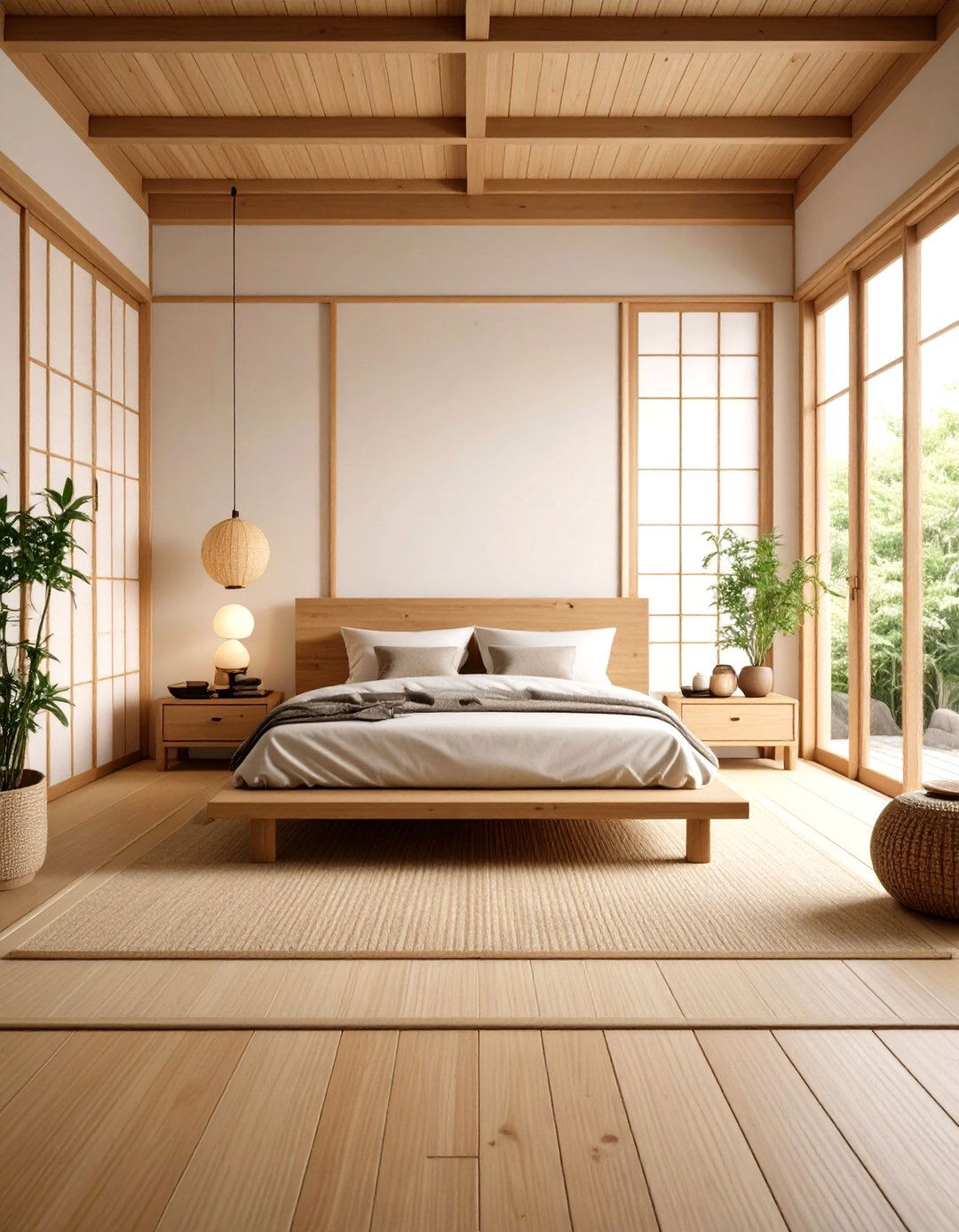
Incorporating bamboo brings sustainable elegance and natural texture to your Japanese bedroom design through furniture, flooring, and decorative accents. Bamboo furniture combines clean Scandinavian lines with oriental aesthetics, creating statement pieces that serve both storage and visual appeal. Bamboo flooring offers durability and visual warmth while maintaining the natural material emphasis crucial to Japanese design. Window treatments made from bamboo provide privacy while filtering natural light beautifully. Bamboo accessories like storage baskets, picture frames, and wall panels add organic texture without overwhelming the space. The material's rapid growth and renewability align with Japanese values of environmental harmony. Its natural color variations from light blonde to rich honey complement neutral color palettes perfectly. Whether choosing bamboo wardrobes, room dividers, or small accent pieces, this material enhances the authentic Japanese bedroom design aesthetic.
5. Japanese Bedroom Design with Paper Lantern Soft Lighting Solutions
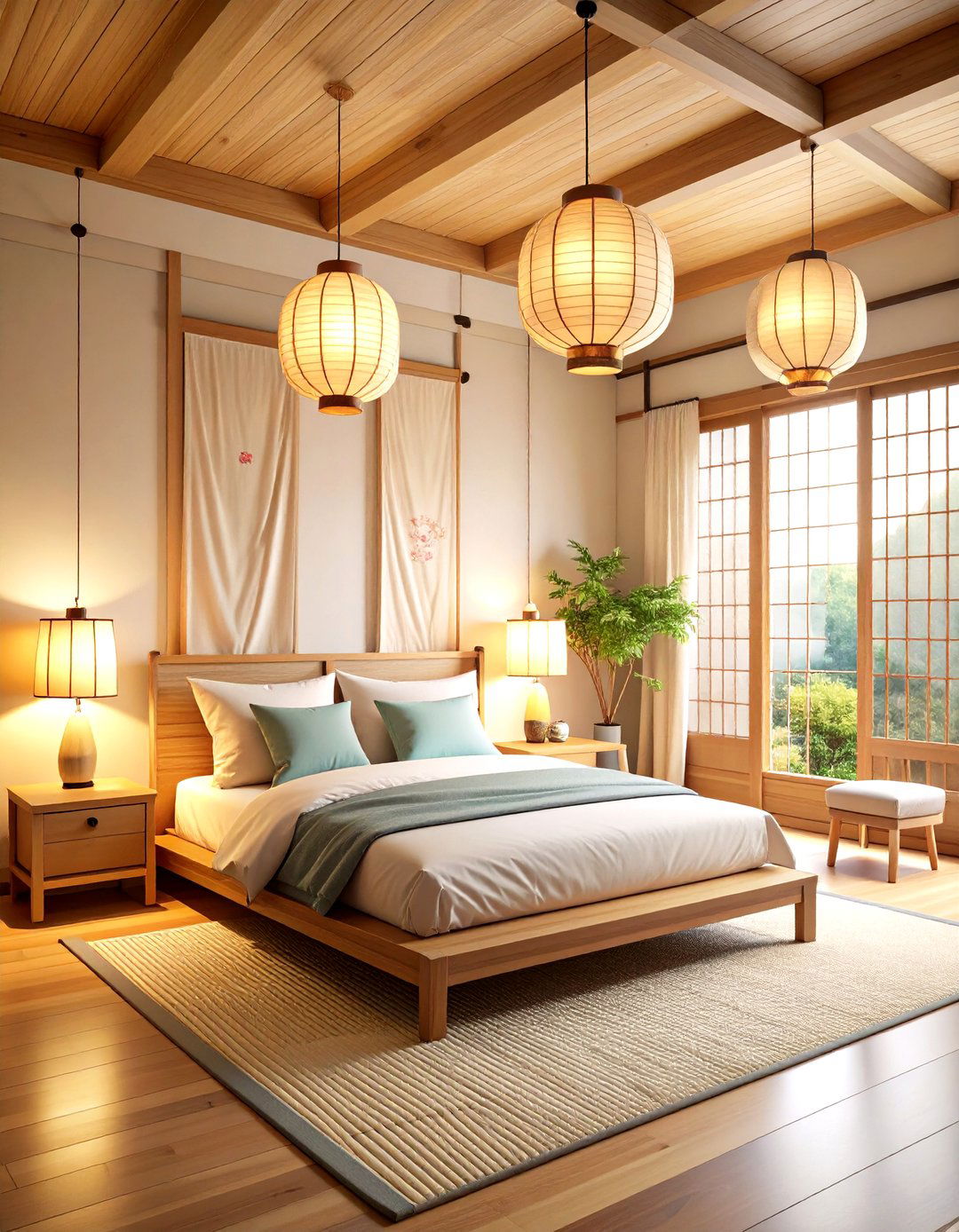
Achieve serene illumination through traditional paper lanterns that create the gentle, diffused lighting essential to Japanese bedroom design ambiance. These lanterns, crafted from rice paper and bamboo frames, emit gentle and calming light that envelops the space in a warm and inviting aura. Made from intertwined mulberry fibers, washi paper is strong while remaining soft and thin enough to diffuse light effectively. Hanging lanterns from the ceiling creates floating light sources that don't compete with furniture placement. Table lanterns provide intimate task lighting for reading or meditation. The red version is the most typical Japanese lantern and can still be found in front of shops and sake bars in Japanese cities. Floor-standing paper lamps offer adjustable ambient lighting options. The soft, non-aggressive illumination promotes relaxation and creates the subdued atmosphere that defines authentic Japanese bedroom design.
6. Japanese Bedroom Design with Minimalist Zen Garden Elements
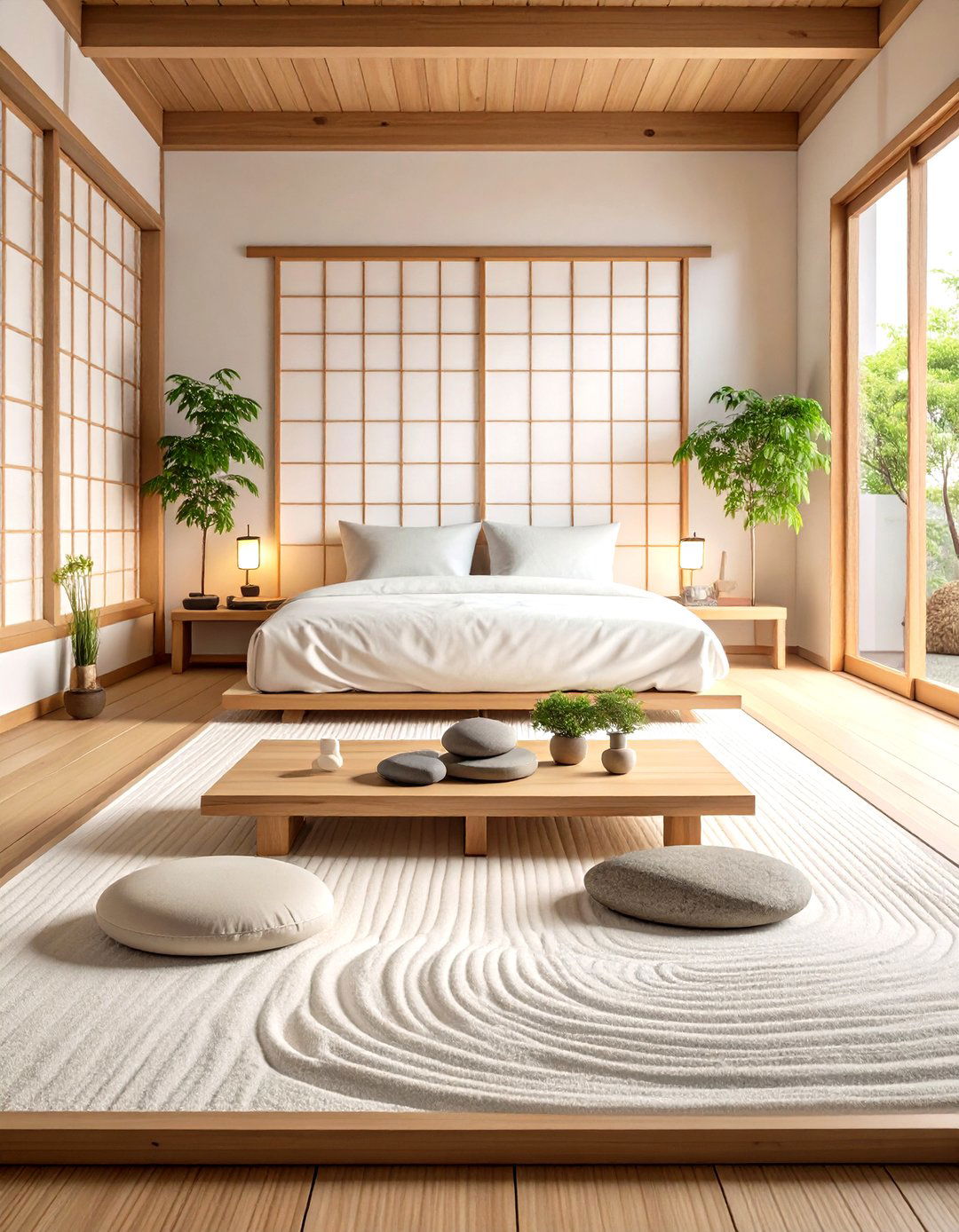
Bring tranquility indoors by incorporating zen garden elements that enhance the meditative quality of Japanese bedroom design spaces. Integrating stones, sand, and plants into bedroom decor evokes serenity and harmony while bringing nature indoors. Small tabletop sand gardens provide focal points for contemplation and stress relief. Using natural materials like gravel or stepping stones creates pathways that invite mindfulness and immersion in tranquil space. Arrange smooth river stones in thoughtful patterns near windows or on floating shelves. A shallow wooden tray filled with fine sand and a small rake offers interactive meditation opportunities. Complement these features with carefully selected stones of varying sizes and textures. The asymmetrical arrangement principle keeps displays natural and organic. These elements create visual calm while providing mental anchoring points that support the Japanese bedroom design philosophy of finding peace through simplicity.
7. Japanese Bedroom Design Emphasizing Natural Wood Furniture and Finishes
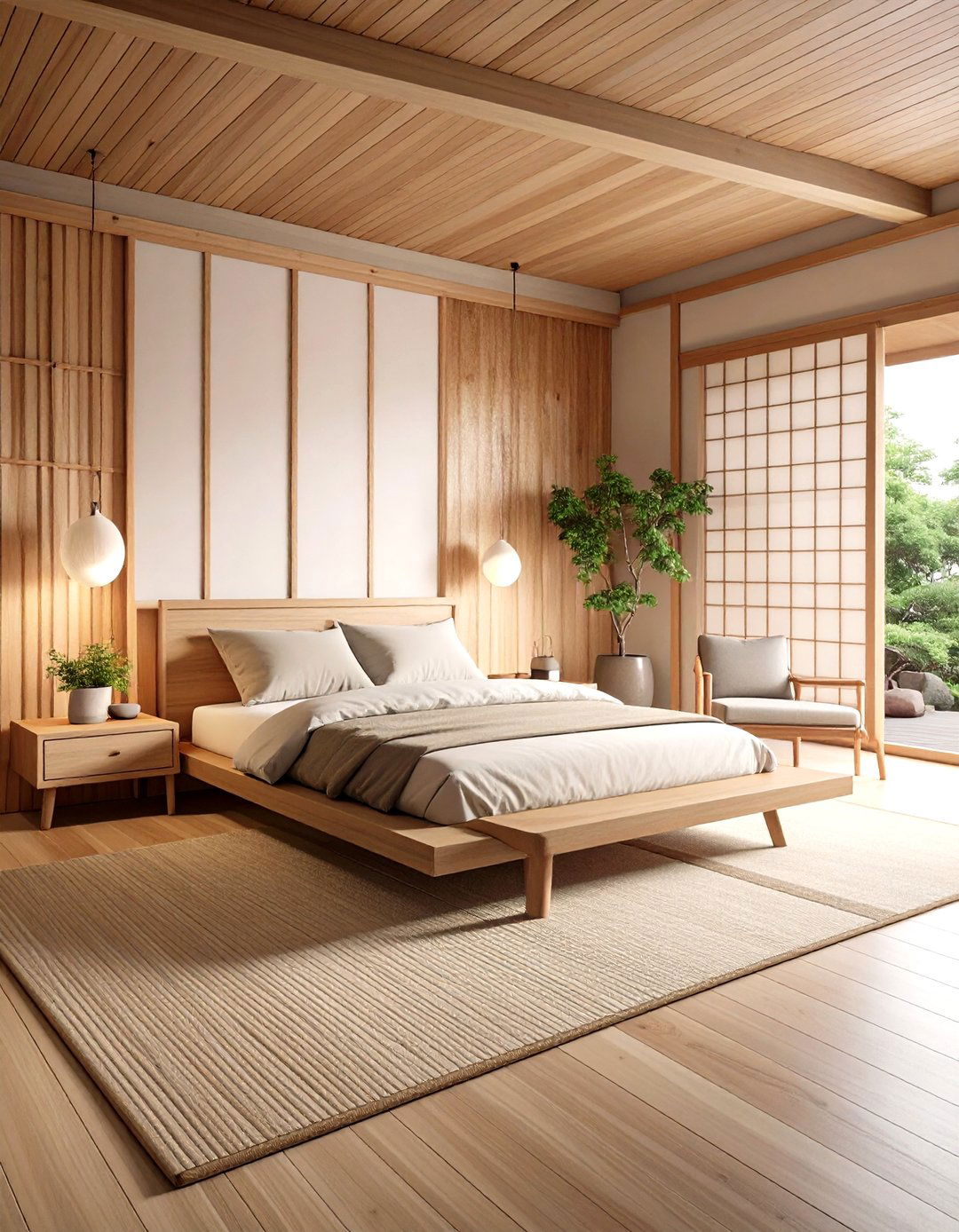
Select natural wood furniture pieces that embody the craftsmanship and material honesty central to Japanese bedroom design traditions. Key elements include low profile furniture, platform beds with simple headboards, and streamlined nightstands made from natural materials. Choose woods like oak, walnut, or pine that showcase natural grain patterns and warm tones. Avoid heavily stained or painted pieces in favor of natural oils that enhance wood's inherent beauty. Vertical wood slats, raw plywood, and hardwood paneling create interesting texture while maintaining clean lines inspired by Japanese Zen design. Built-in storage solutions using matching wood maintain visual continuity. Floating nightstands and wall-mounted shelving preserve floor space and enhance the room's airy quality. The key lies in selecting pieces that demonstrate functional beauty while supporting the minimalist aesthetic that defines authentic Japanese bedroom design.
8. Japanese Bedroom Design with Traditional Futon Floor Sleeping Systems
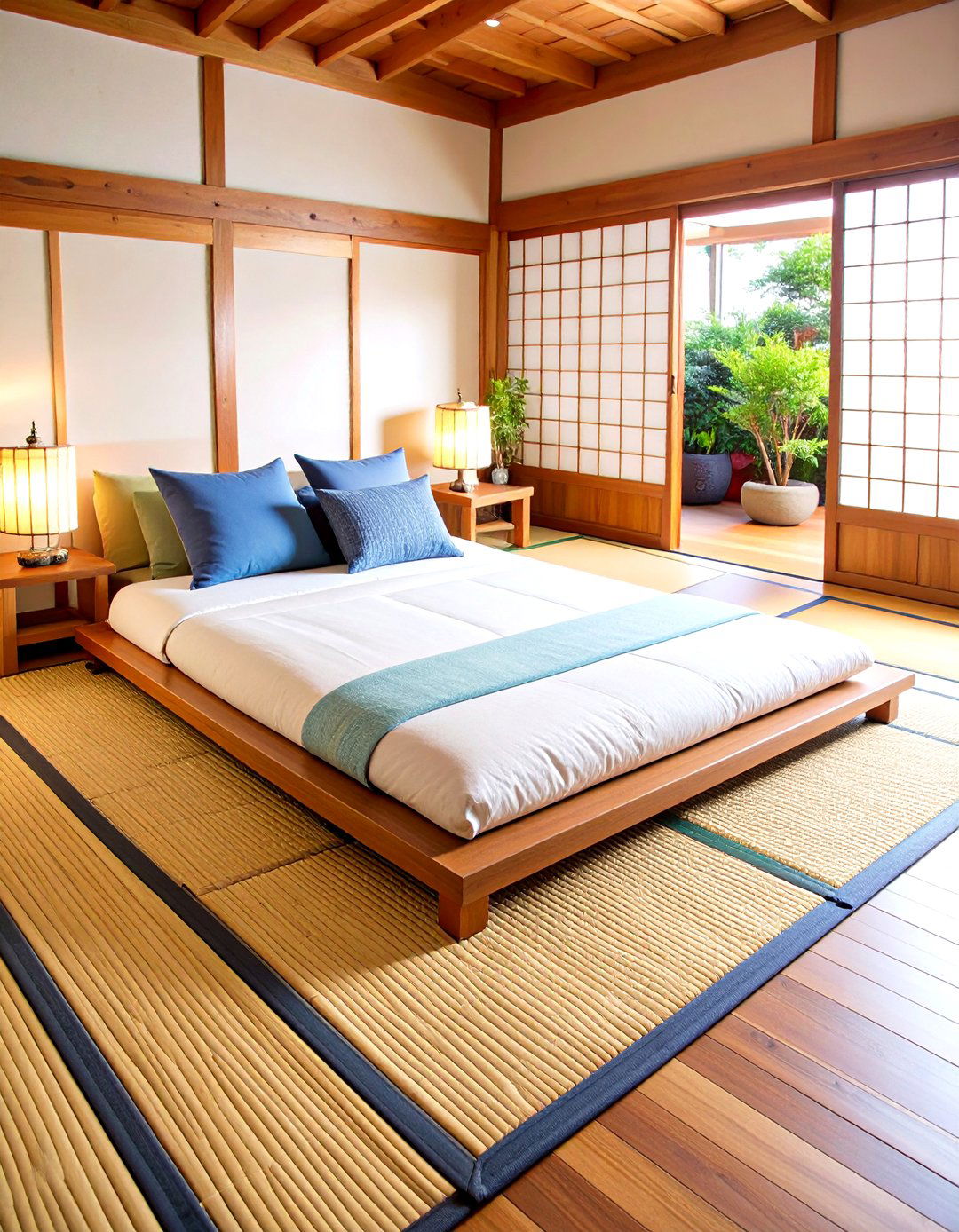
Experience authentic Japanese sleeping traditions through futon systems that connect your Japanese bedroom design directly with cultural practices spanning centuries. The Shikibuton Japanese futon is a traditional bed usually used on tatamis and folded during the day for storage. These mattresses are designed specifically for floor use, making them perfect for limited space or minimalist aesthetics. Traditional futons offer firm support that promotes proper spinal alignment and deeper sleep. During the day, simply fold and store the futon, transforming your bedroom into a multi-purpose space. The cotton compresses over time and offers firm comfort, commonly used by people seeking very firm sleeping surfaces. Pair with traditional Japanese pillows filled with buckwheat hulls for complete authenticity. This sleeping arrangement embodies the Japanese principles of simplicity, functionality, and space efficiency while maintaining connection to time-honored traditions.
9. Japanese Bedroom Design Incorporating Living Plant Elements and Bonsai
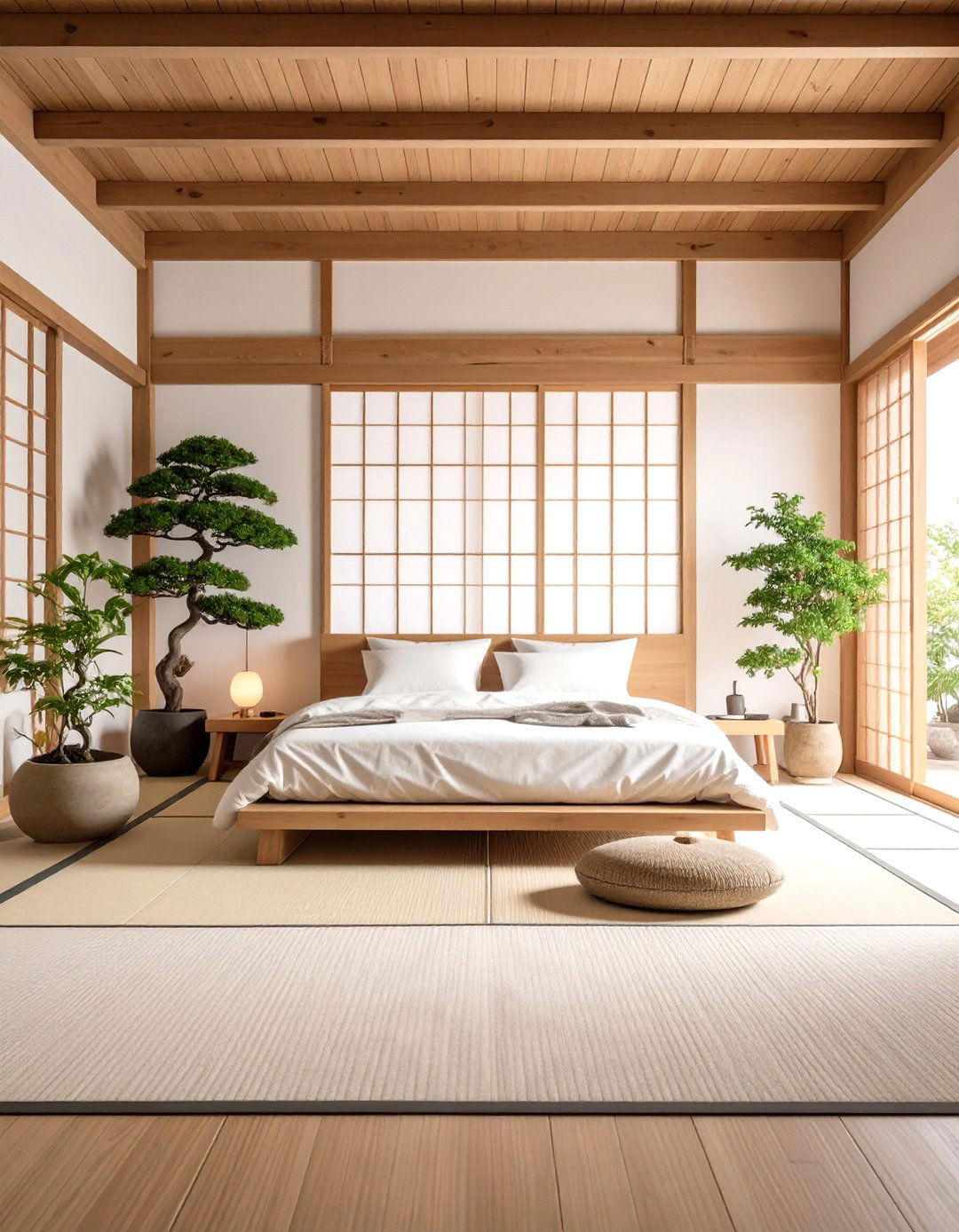
Cultivate serenity through carefully selected plants that bring life and natural beauty to Japanese bedroom design without overwhelming the minimalist aesthetic. Potted plants and bonsai trees bring vitality to bedrooms while enhancing connection to nature. Bonsai trees serve as living art pieces that require mindful care, supporting the meditative aspects of Japanese design philosophy. Select low-maintenance plants like snake plants, peace lilies, or small ferns that thrive in bedroom conditions. Place plants strategically near windows or on floating shelves to create natural focal points. Small bamboo plants in simple ceramic containers align perfectly with Japanese design principles. Hanging plants can add vertical interest without consuming floor space. The key is restraint—choose fewer, higher-quality plants rather than crowding the space. These living elements purify air while reinforcing the Japanese bedroom design connection between interior spaces and the natural world.
10. Japanese Bedroom Design with Neutral Earth Tone Color Palettes
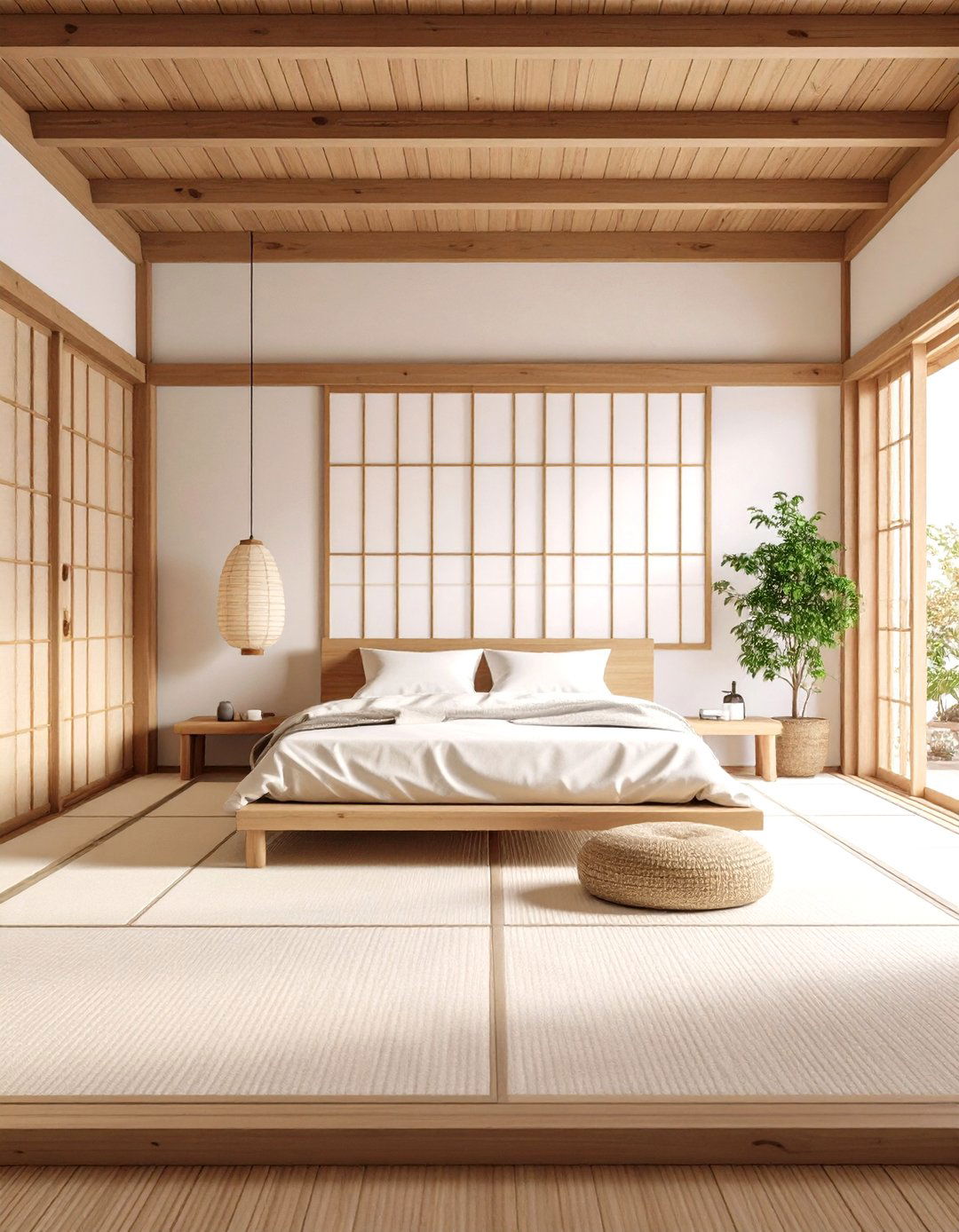
Create harmony through carefully curated neutral colors that form the foundation of peaceful Japanese bedroom design environments. Colors commonly used include natural earth tones such as beige, brown, and green, with bright colors generally avoided in favor of subdued tones. Japandi bedrooms are renowned for their soothing color schemes that seamlessly blend Japanese and Scandinavian aesthetics. Warm whites, soft grays, and cream tones create spacious feelings while maintaining warmth. Incorporate deeper accent colors through natural materials like wood grain or stone textures. Muted colors help maintain balanced, calming spaces that promote tranquility. Avoid overwhelming patterns in favor of subtle texture variations within the neutral palette. The monochromatic approach reduces visual stress and enhances the sense of spaciousness essential to Japanese bedroom design. These timeless color choices support restful sleep while creating sophisticated, enduring beauty.
11. Japanese Bedroom Design with Sliding Fusuma Door Storage Solutions
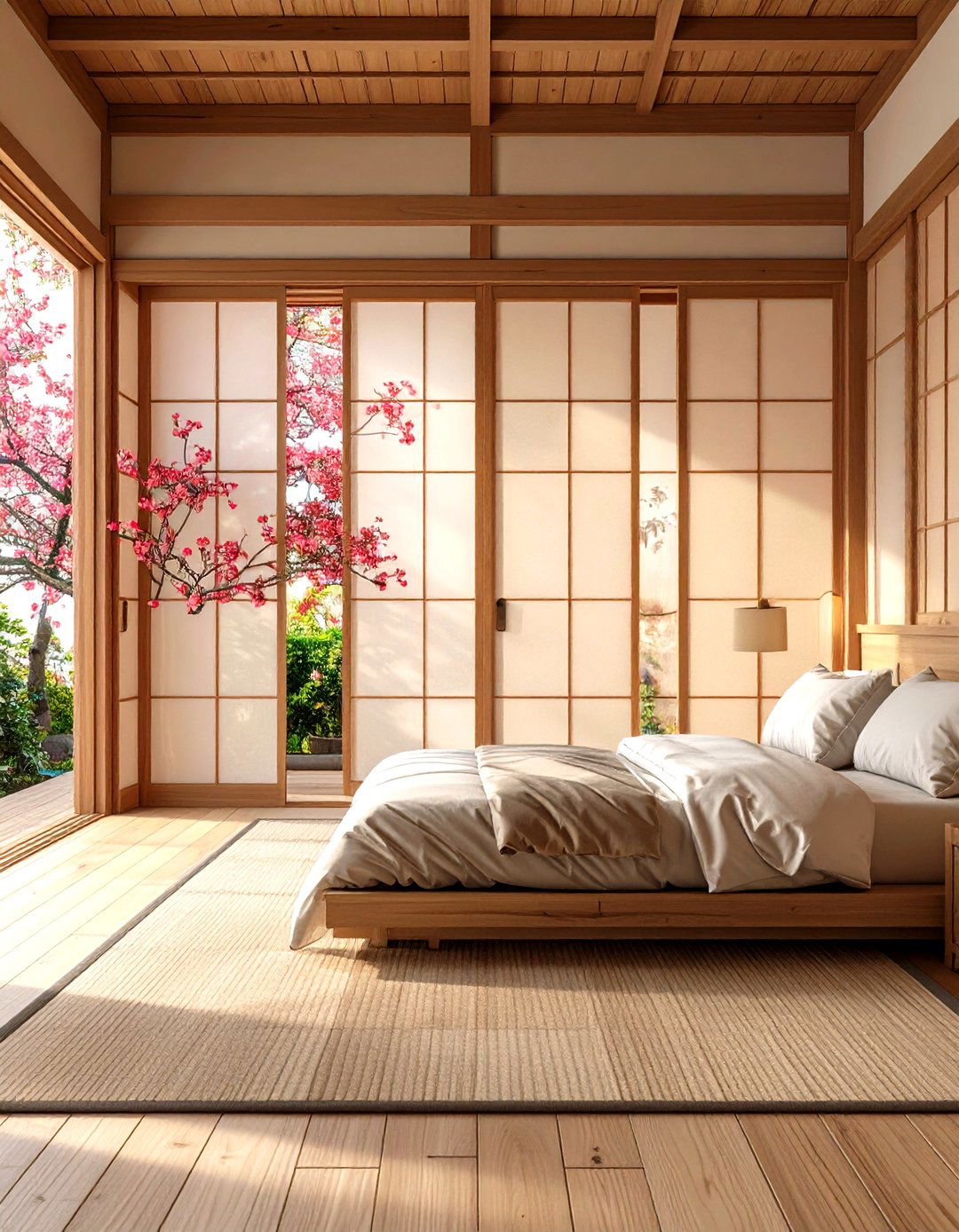
Maximize space efficiency using traditional fusuma sliding doors that provide both storage and aesthetic appeal in Japanese bedroom design layouts. These elegant doors, typically made of paper-covered wooden frames, offer seamless functionality and beauty while allowing easy space division. Unlike traditional hinged doors, fusuma panels slide effortlessly along tracks, optimizing floor space usage. By sliding along tracks, these doors optimize floor space and provide versatile room configurations, making them ideal for smaller bedrooms or minimalist aesthetics. Use fusuma doors to conceal closets, storage areas, or even entire room sections. The translucent panels maintain visual continuity while providing privacy when needed. Modern interpretations may feature different materials while preserving the original aesthetic principles. Install these doors to create flexible spaces that adapt to daily needs while maintaining the clean, uncluttered appearance fundamental to Japanese bedroom design philosophy.
12. Japanese Bedroom Design with Hidden Storage and Decluttered Surfaces
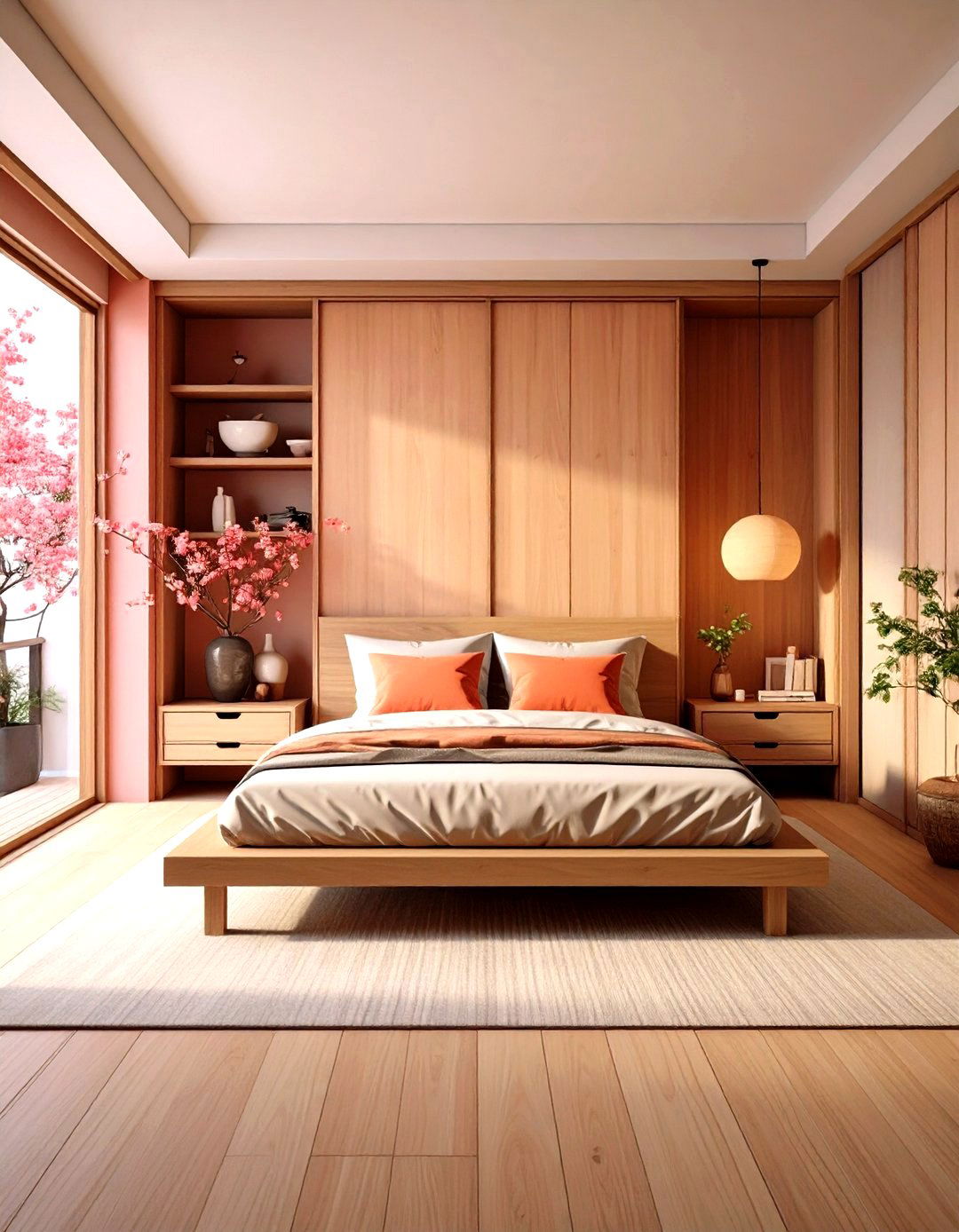
Achieve visual serenity through ingenious hidden storage solutions that maintain the clean surfaces essential to Japanese bedroom design principles. Built-in storage solutions hide away clutter while decor focuses on symmetry and alignment to promote calm and organized minds. Under-bed drawers in platform frames provide extensive storage without visual impact. Wall-mounted cabinets with flush doors maintain smooth wall surfaces. Built-in wardrobes with sliding panels eliminate furniture bulk while maximizing capacity. Hidden storage keeps rooms tidy and is great for Japanese bedroom design in small spaces. Floating nightstands with concealed compartments offer bedside storage without floor clutter. The Japanese concept of "less is more" applies to visible objects—store everything possible out of sight. This approach creates the mental clarity and visual calm that supports restful sleep while honoring the minimalist principles central to authentic Japanese bedroom design.
13. Japanese Bedroom Design with Ikebana Floral Arrangement Focal Points
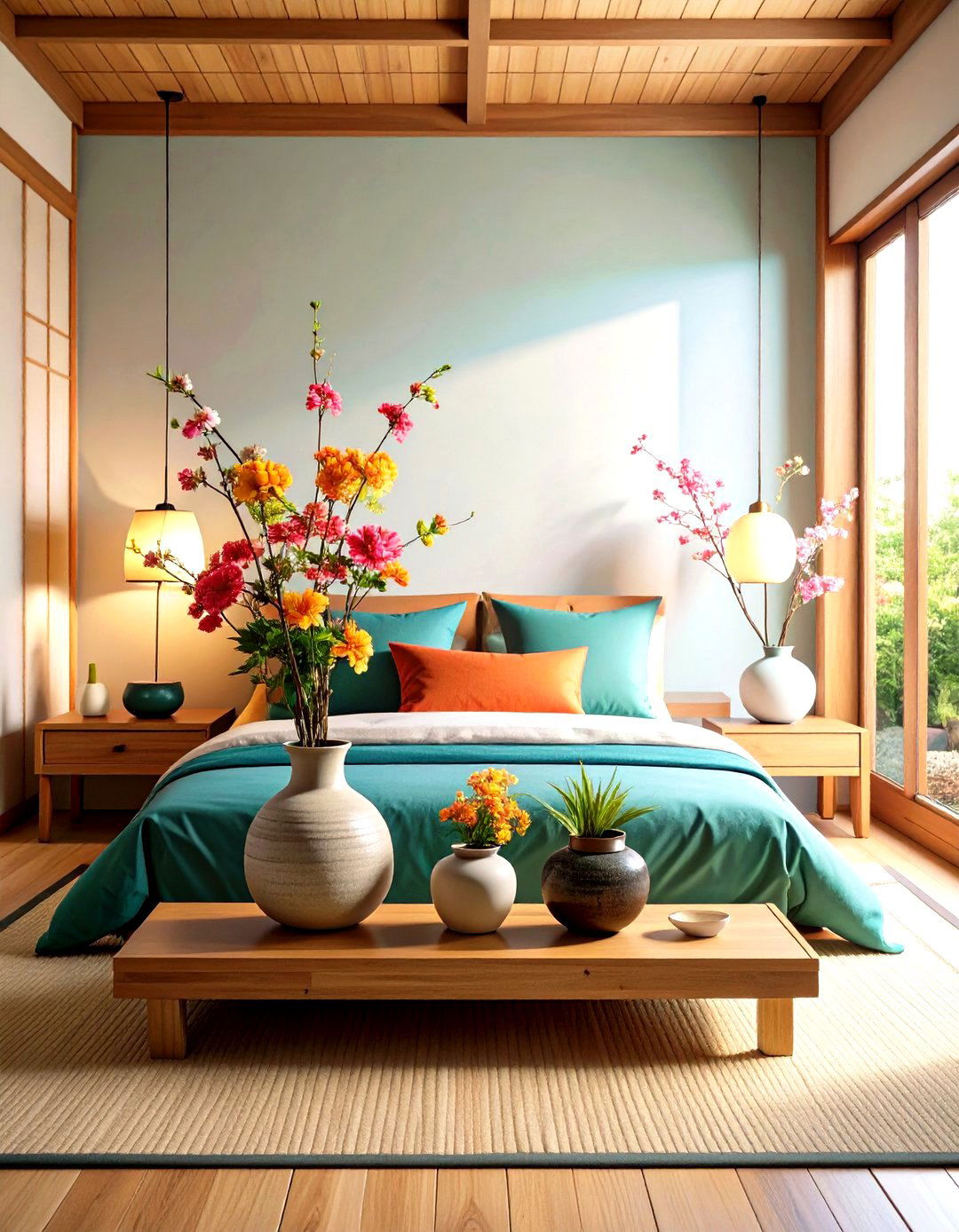
Bring artistic beauty through ikebana flower arrangements that serve as living art within your Japanese bedroom design composition. Ikebana is a special way to arrange flowers that looks simple and pretty, using specific techniques different from normal flowers in vases. This traditional art form emphasizes line, form, and space rather than color abundance. Select one or two stems with interesting shapes or textures rather than full bouquets. Use simple ceramic or bamboo containers that complement your room's neutral palette. Position arrangements on floating shelves, low tables, or near windows where natural light enhances their beauty. Change arrangements seasonally to maintain freshness and connection with natural cycles. The asymmetrical balance principles of ikebana align perfectly with Japanese design aesthetics. These arrangements provide color and life while maintaining the restraint and mindfulness that characterize authentic Japanese bedroom design philosophy.
14. Japanese Bedroom Design with Organic Natural Textile Integration
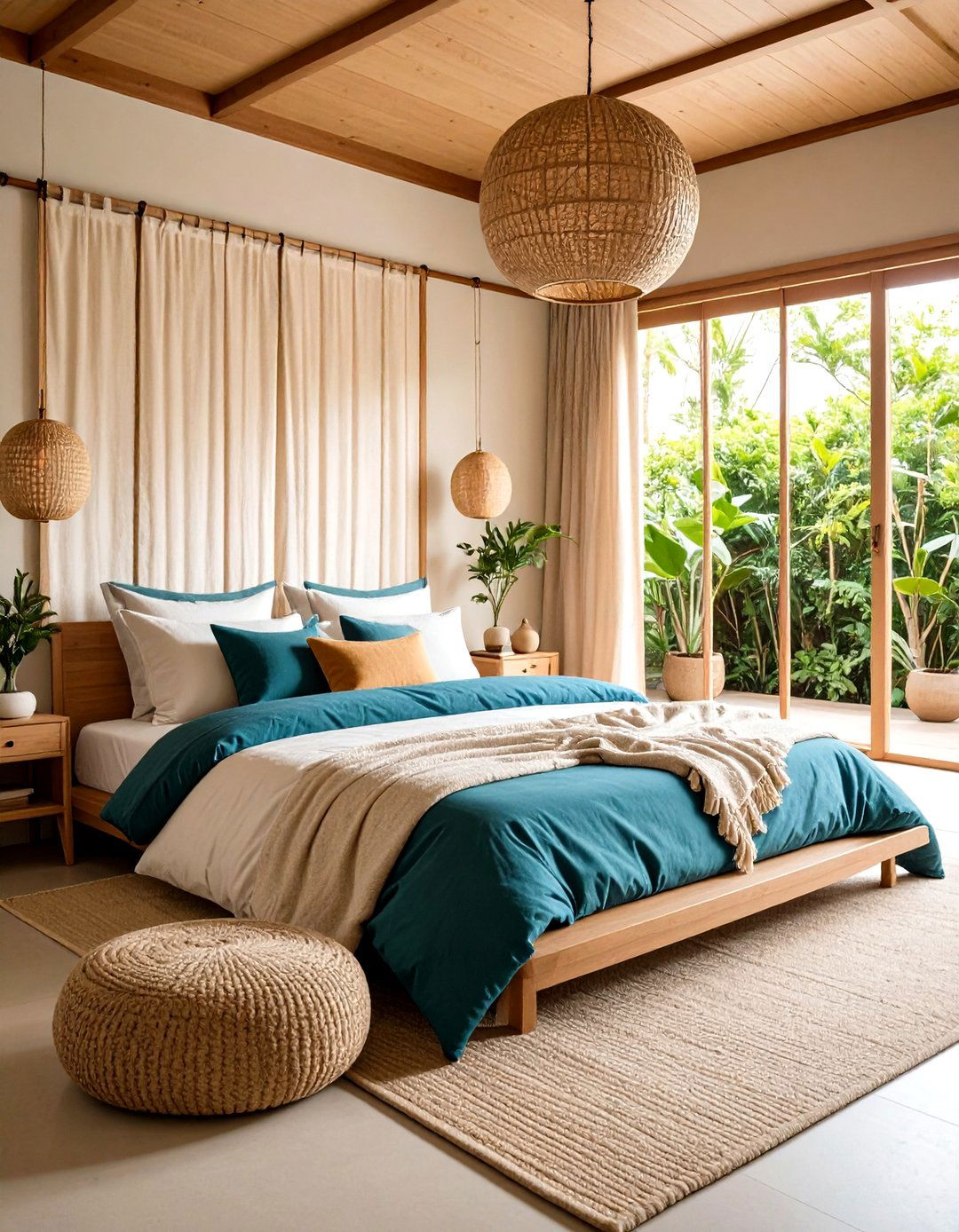
Select natural textiles that enhance comfort while maintaining the organic material emphasis fundamental to Japanese bedroom design aesthetics. Natural materials like linen, cotton, and wool add texture while promoting connection to nature. Soft, natural sheets feel nice and fit with Japanese bedroom style while providing comfortable sleep surfaces. Choose bedding in neutral tones made from organic cotton, linen, or hemp for breathability and comfort. Wool throws provide warmth without synthetic materials. Simple geometric patterns or subtle textures work better than bold prints. Natural fiber rugs add warmth underfoot while maintaining the organic theme. Hemp or linen curtains filter light beautifully while supporting sustainability values. Avoid synthetic materials that conflict with the natural material philosophy. These textile choices support better sleep quality while reinforcing the Japanese bedroom design connection between comfort, sustainability, and aesthetic beauty.
15. Japanese Bedroom Design with Stone and Pebble Decorative Accents
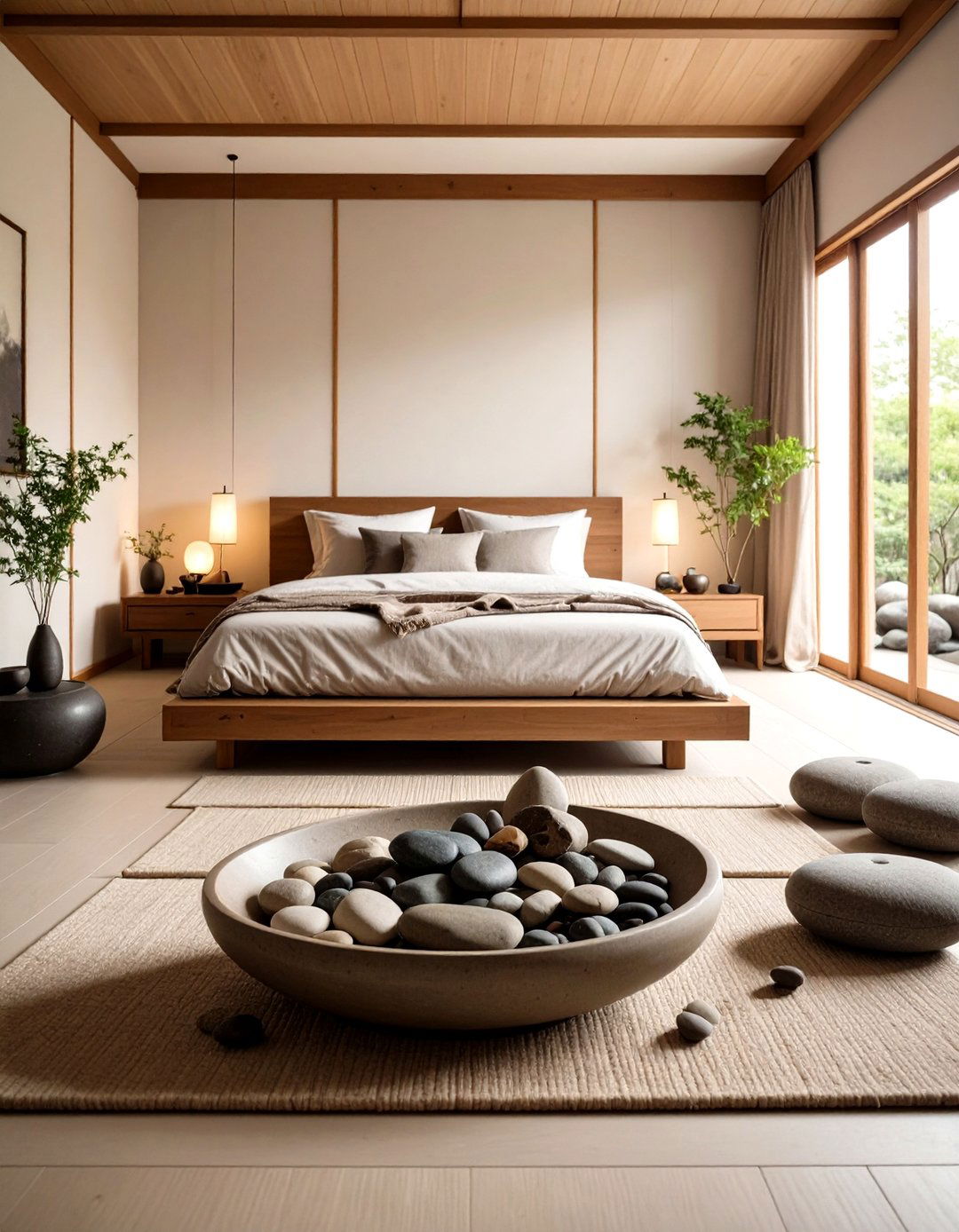
Incorporate natural stones and pebbles that ground your space while adding tactile interest to Japanese bedroom design arrangements. A few stones or pebbles as decorations bring nature inside, just like in Japanese gardens. Arrange smooth stones in mindful patterns or scatter them throughout the space to add grounding presence. Select stones with interesting textures, colors, or shapes that speak to you personally. Group odd numbers of stones following Japanese asymmetrical balance principles. Place collections on floating shelves, low tables, or window sills. River rocks in shallow ceramic bowls create meditative focal points. Larger stones can anchor floor arrangements near seating areas. The natural variations in color and texture add visual interest without overwhelming the space. These elements connect your bedroom with earth energy while supporting the Japanese bedroom design philosophy of finding beauty in natural simplicity.
16. Japanese Bedroom Design with Floor Cushion Seating Areas
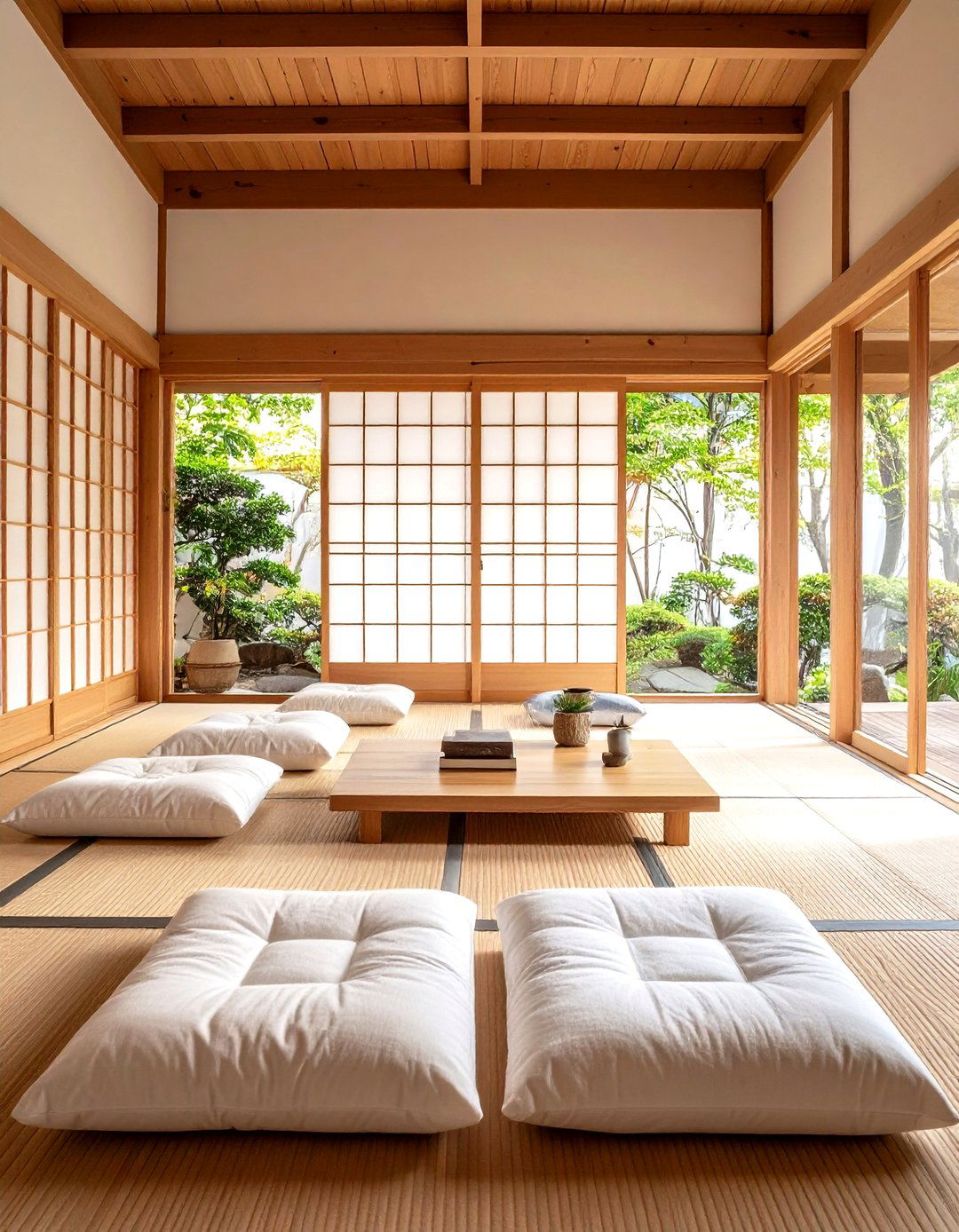
Create flexible seating arrangements using traditional floor cushions that enhance the low-profile living approach central to Japanese bedroom design philosophy. Big, comfy cushions on the floor are great for sitting and relaxing in Japanese style. Zabuton cushions provide support when sitting cross-legged while avoiding pressure on ankles and knees. These square cushions traditionally accompany low tables for tea ceremonies or meditation. Choose cushions covered in natural fabrics like cotton or linen in neutral colors. Arrange cushions near windows for natural light during reading or meditation. Store cushions easily when not in use to maintain clear floor space. The flexibility allows you to reconfigure seating based on activities or guest needs. This approach supports the Japanese bedroom design principle of multi-functional spaces while maintaining connection to traditional sitting practices and floor-level living philosophy.
17. Japanese Bedroom Design with Handcrafted Ceramic and Pottery Elements
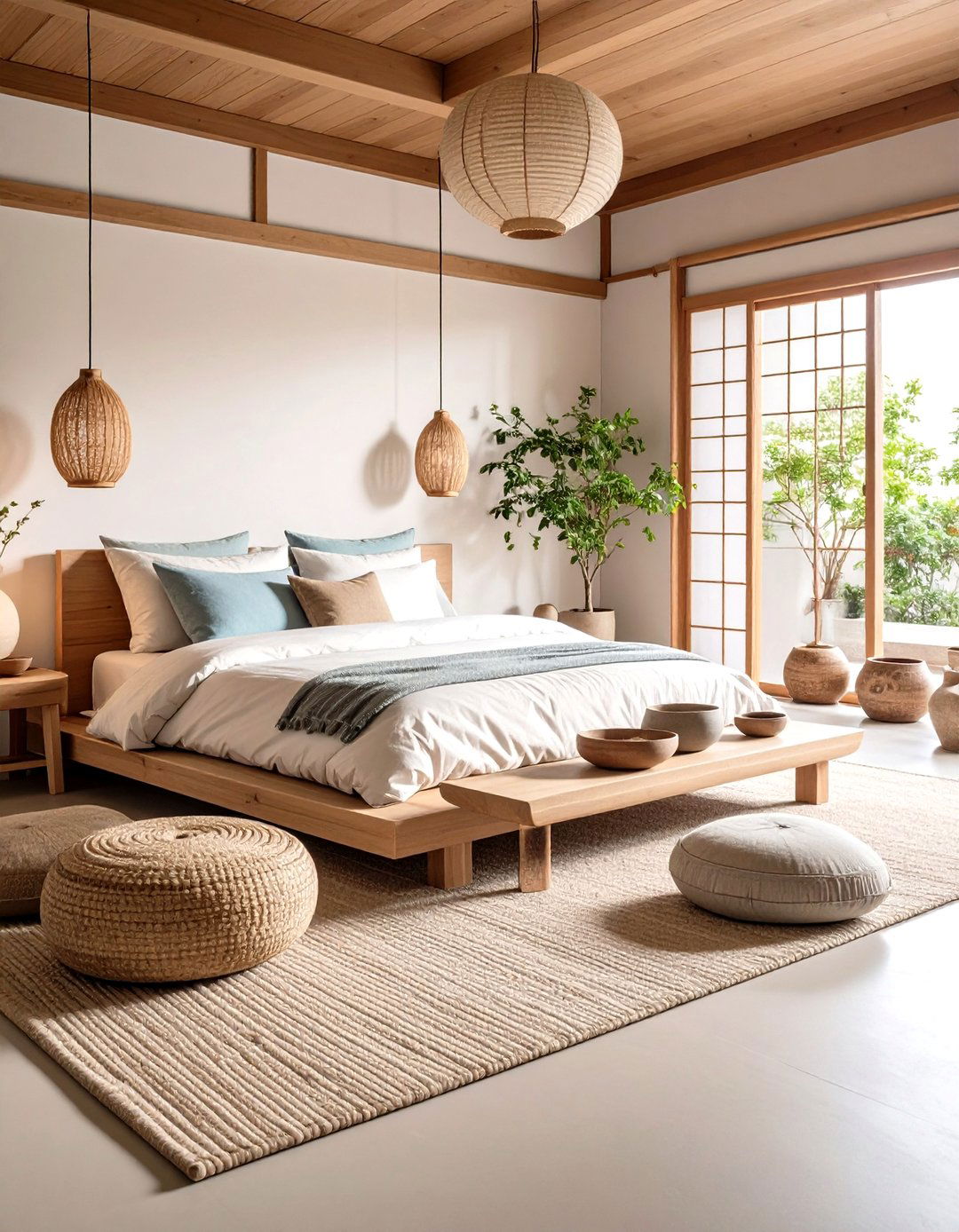
Add artisanal beauty through carefully selected ceramics that provide functional art within Japanese bedroom design compositions. Incorporate elements of wabi-sabi, the Japanese concept of finding beauty in imperfection, through handcrafted ceramics. Select pieces with subtle imperfections that demonstrate human craftsmanship rather than machine precision. Simple ceramic bowls hold small items like jewelry or stones. Pottery vases showcase single stem arrangements following ikebana principles. Choose pieces in earth tones that complement your neutral color palette. Glazes with natural variations add visual interest without overwhelming simplicity. A pretty tea set can be both useful and decorative in Japanese-themed bedrooms. Small ceramic dishes organize bedside essentials beautifully. The handmade quality connects your space with traditional craft traditions while supporting the Japanese bedroom design appreciation for functional beauty and authentic materials.
18. Japanese Bedroom Design with Vertical Wood Slat Accent Walls
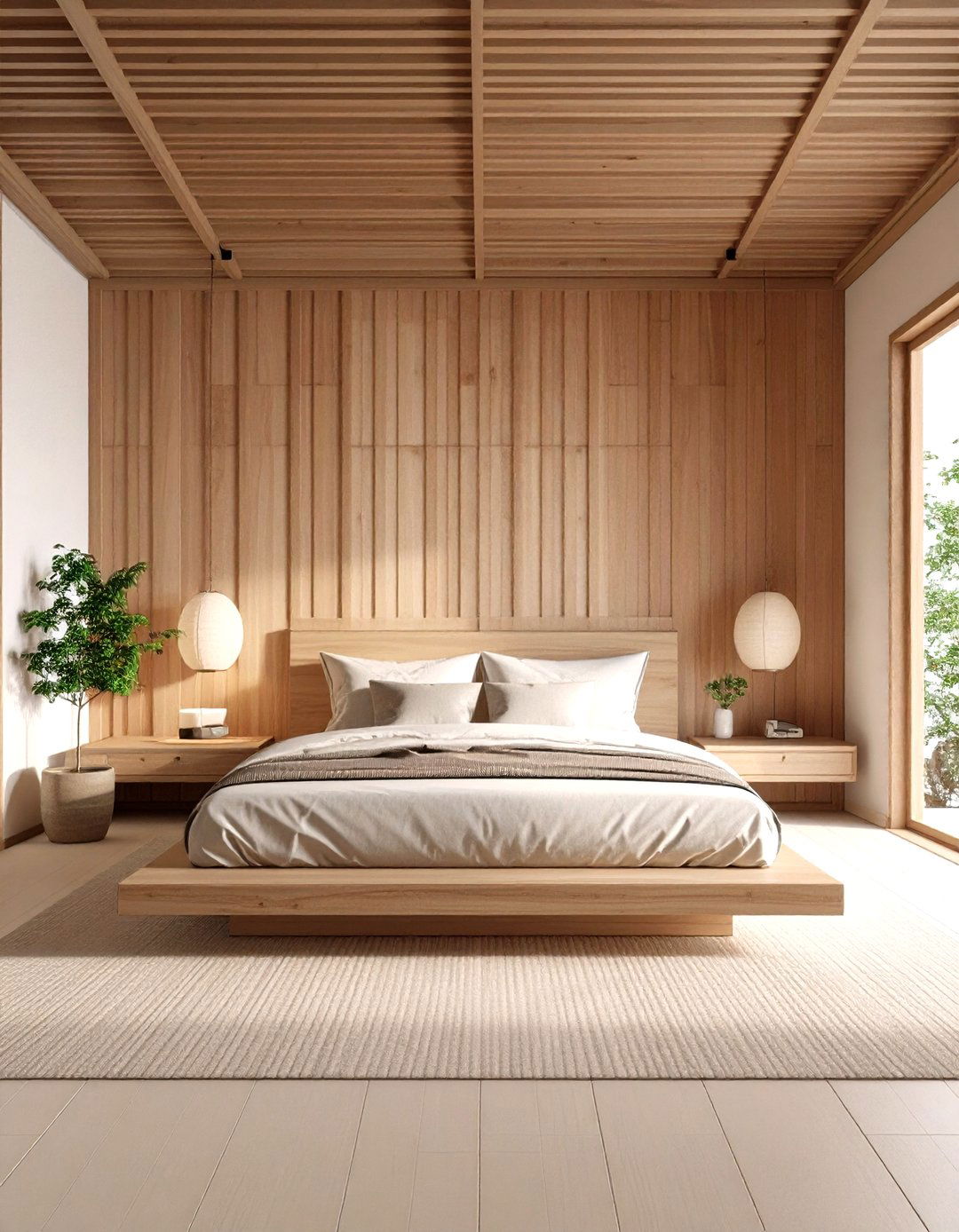
Create architectural interest through vertical wood slat installations that add texture and warmth to Japanese bedroom design environments. Vertical wood slats combined with neutral color palettes create Japanese-inspired bedrooms with modern touches. These installations provide visual depth without overwhelming the minimalist aesthetic. Install slats behind the bed as a natural headboard alternative. Rich natural wood surfaces draw significant inspiration from Japanese Zen design style through minimalist space focus. Choose woods that match other furniture pieces for visual continuity. Spacing between slats creates shadow patterns that change throughout the day. The vertical lines draw the eye upward, making ceilings appear higher. This treatment adds architectural detail while maintaining the clean, uncluttered surfaces essential to Japanese design. The natural wood brings warmth and organic texture that supports the Japanese bedroom design philosophy of harmony between built and natural environments.
19. Japanese Bedroom Design with Modern Japandi Fusion Elements
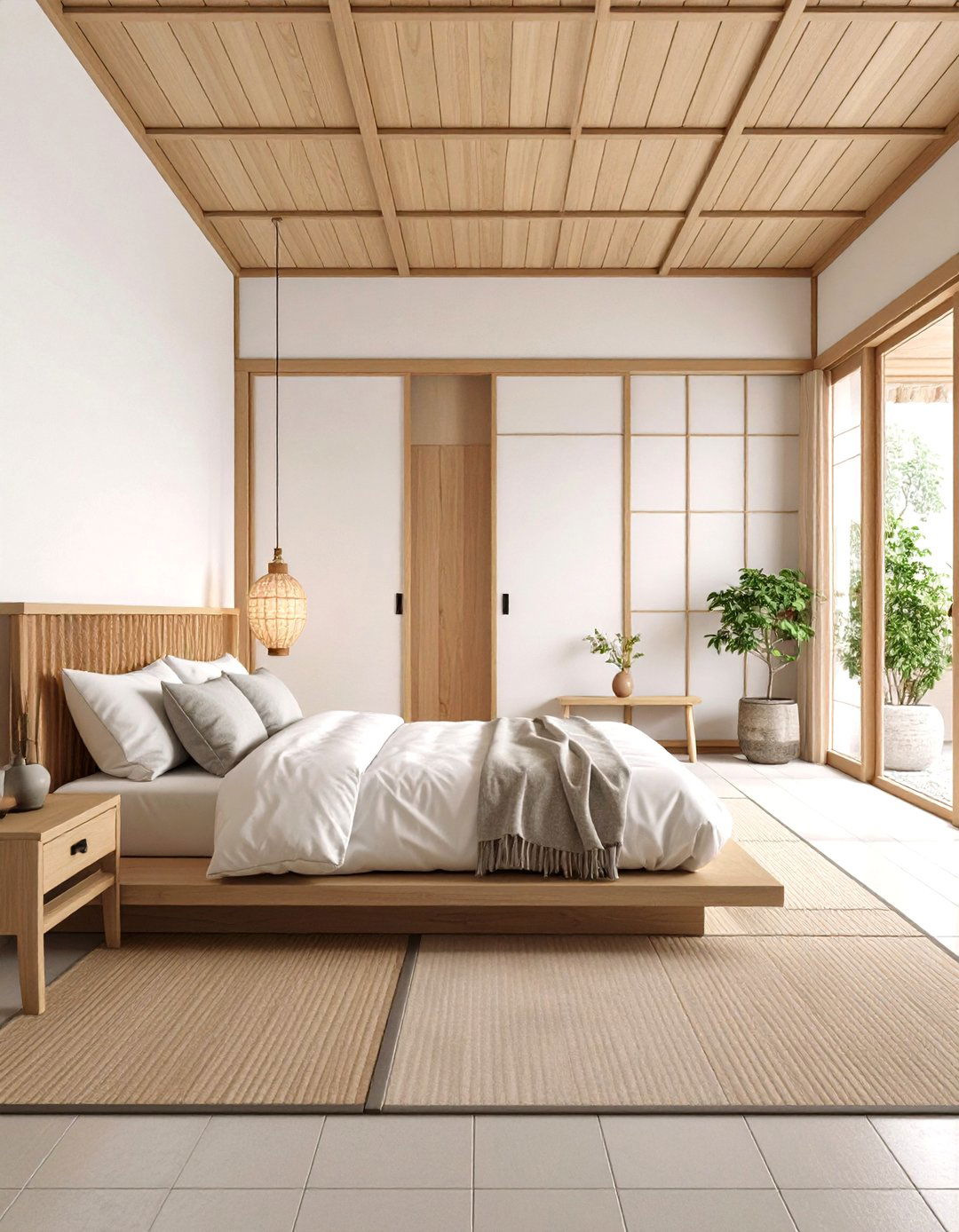
Blend Japanese minimalism with Scandinavian coziness to create contemporary Japandi-style Japanese bedroom design that suits modern lifestyles. Japandi combines calming elements of nature and clean lines to help bodies relax after long days or wake calmly during stressful times. This fusion style emphasizes simplicity, functionality, and connection to nature, resulting in bedrooms that feel both elegant and comfortable. Incorporate hygge elements like soft throws and warm lighting with Japanese minimalism. The combination showcases Japanese minimalism with warm color palettes, playing with different light wood tones. Add cozy textiles while maintaining clean lines and neutral palettes. The approach allows more personality expression while preserving Japanese design principles. This modern interpretation makes Japanese bedroom design more accessible to Western lifestyles while maintaining essential elements of tranquility, functionality, and natural beauty.
20. Japanese Bedroom Design with Water Feature Sound Elements
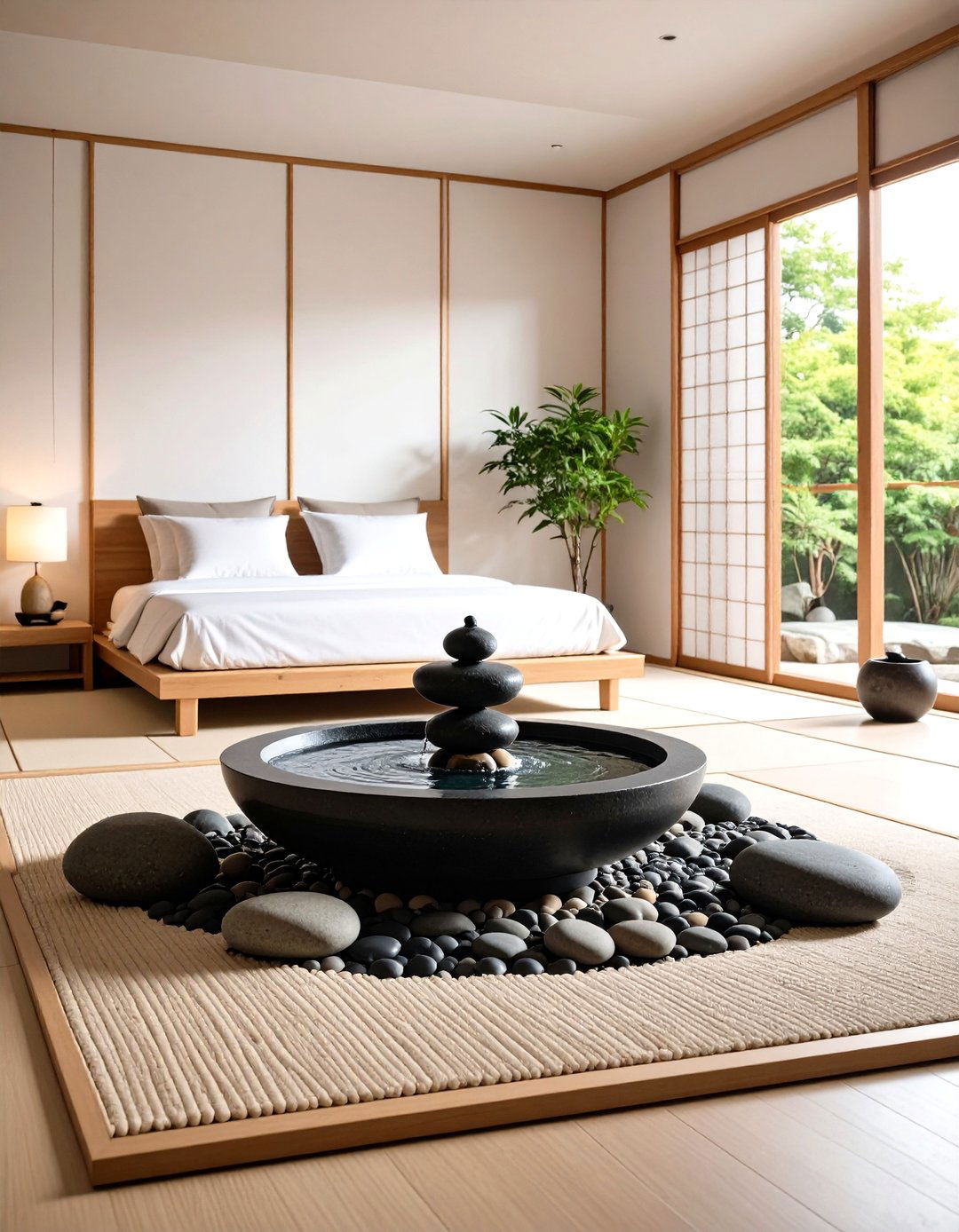
Enhance tranquility through gentle water sounds that complete the sensory experience of your Japanese bedroom design sanctuary. The sound of gentle water can help you relax, with small fountains fitting perfectly in Japanese-style bedrooms. Tabletop fountains provide soothing background sounds that mask urban noise while promoting relaxation. Choose designs that complement your room's aesthetic through natural materials and simple forms. Position fountains near seating areas where you can enjoy both visual and auditory benefits. These black basalt fountains create pleasing visual and sound effects while attracting birds to outdoor spaces. The gentle trickling sound supports meditation and sleep preparation routines. Small fountains with river rocks maintain the natural element emphasis crucial to Japanese design. This addition completes the multi-sensory approach to Japanese bedroom design by engaging hearing alongside sight, touch, and smell through other natural elements.
Conclusion:
Japanese bedroom design offers timeless principles for creating peaceful, restorative spaces that promote both physical comfort and mental well-being. Through careful integration of natural materials, minimalist aesthetics, and traditional elements, these design approaches transform ordinary bedrooms into tranquil sanctuaries. Whether embracing fully traditional elements like tatami mats and futons or incorporating modern Japandi interpretations, the key lies in maintaining simplicity, functionality, and connection with nature. The emphasis on quality over quantity, hidden storage solutions, and organic materials creates environments that support restful sleep and daily mindfulness. By thoughtfully selecting elements that resonate with your lifestyle while honoring these ancient design principles, you can create a Japanese-inspired bedroom that serves as a daily retreat from modern life's complexities.



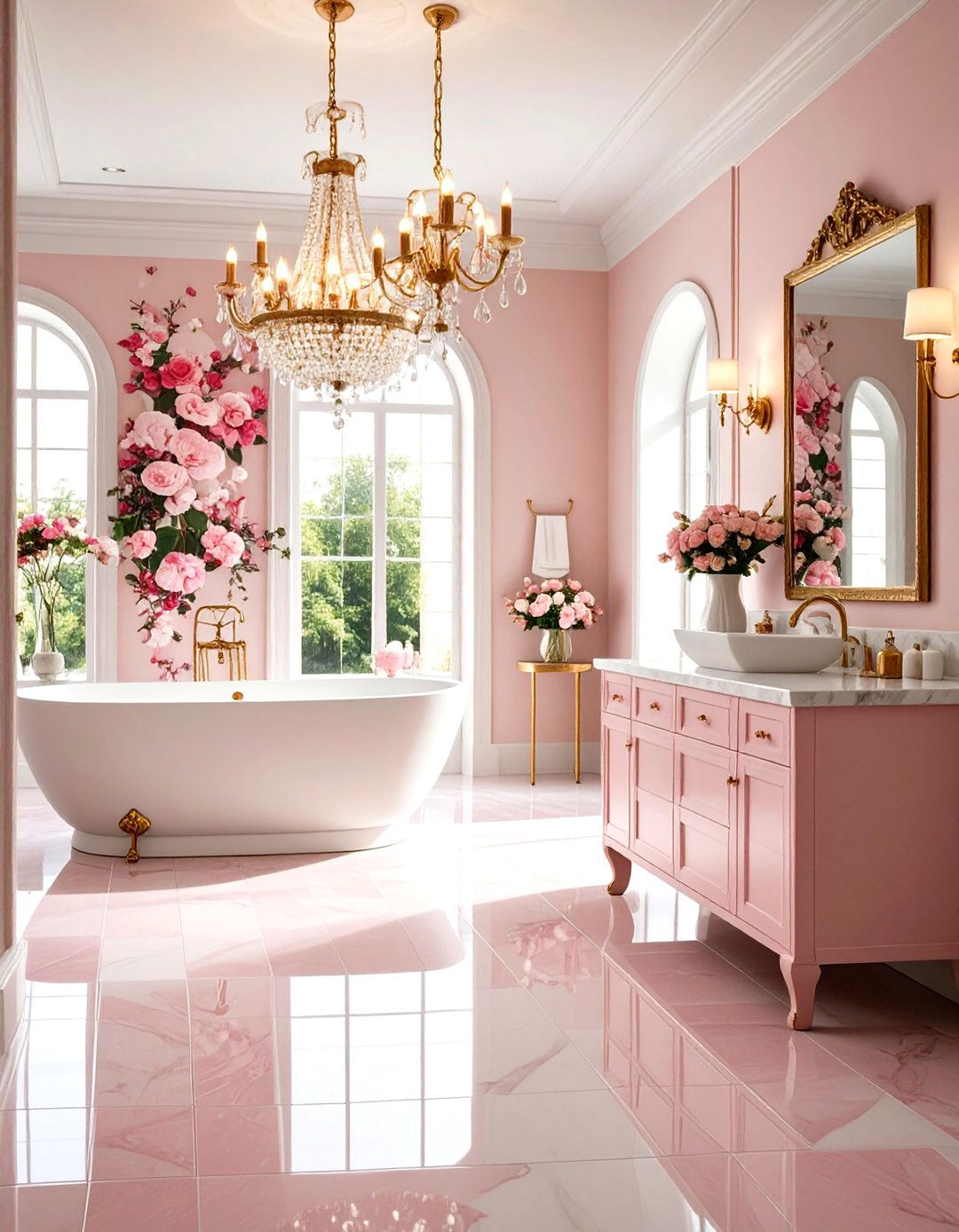
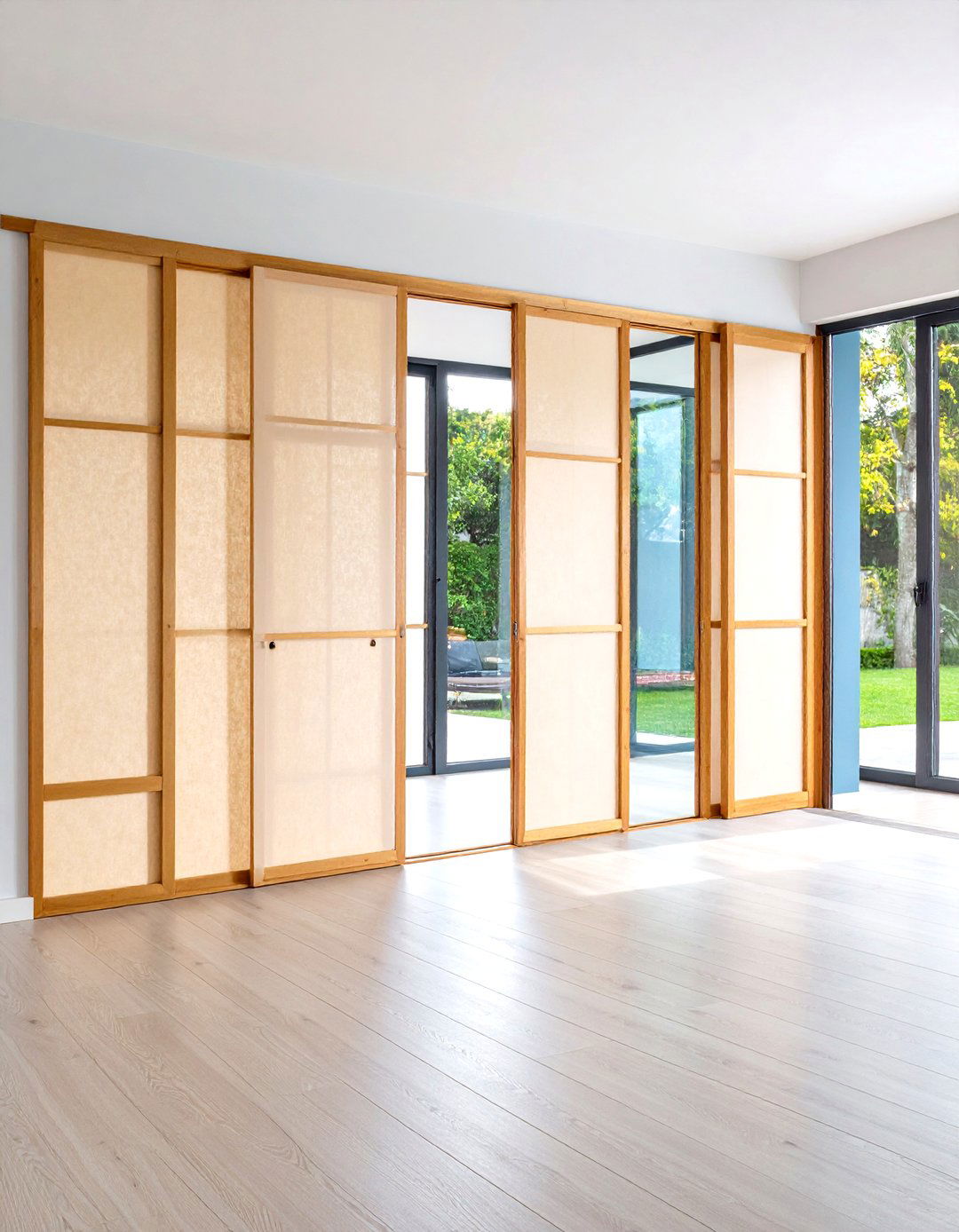
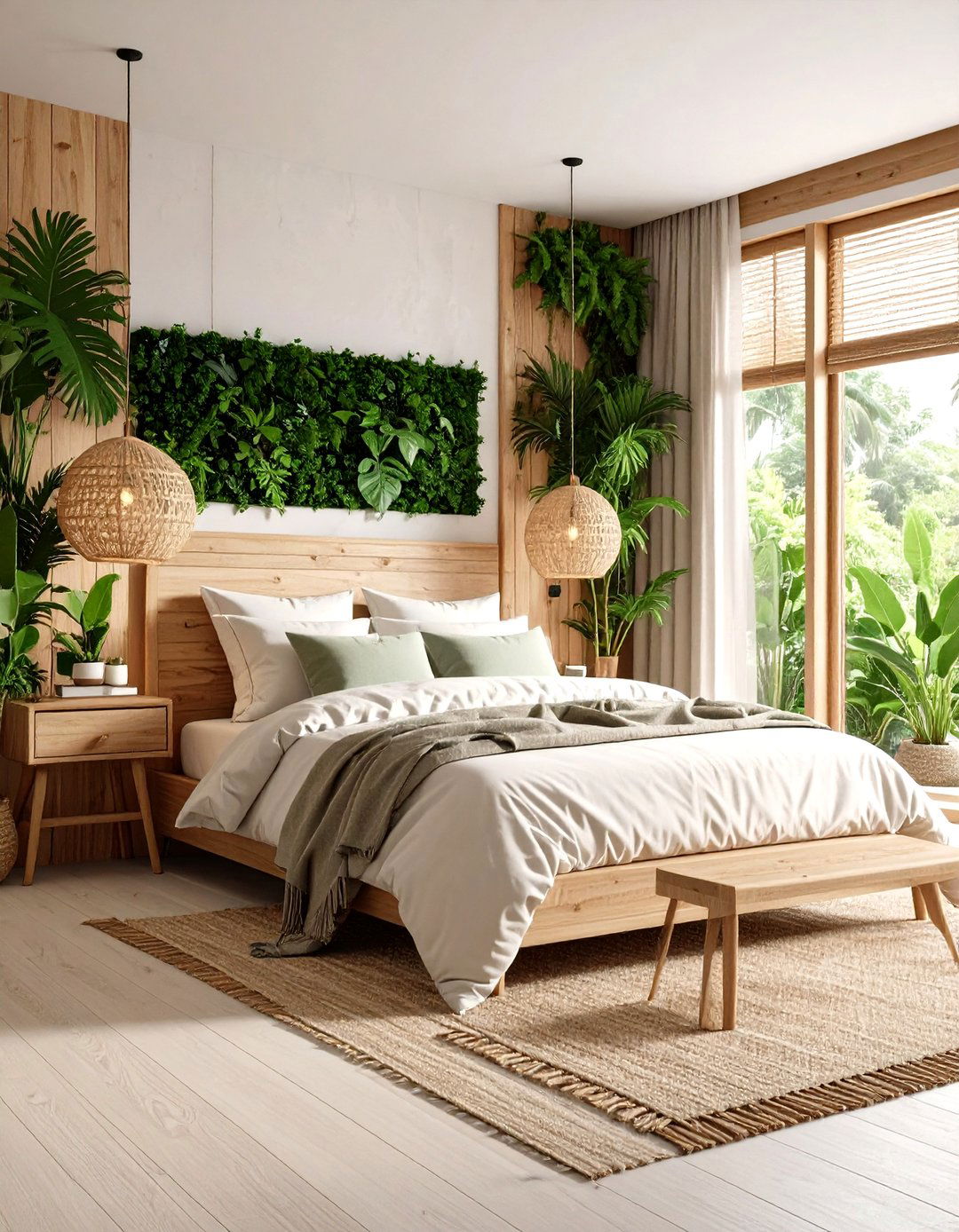

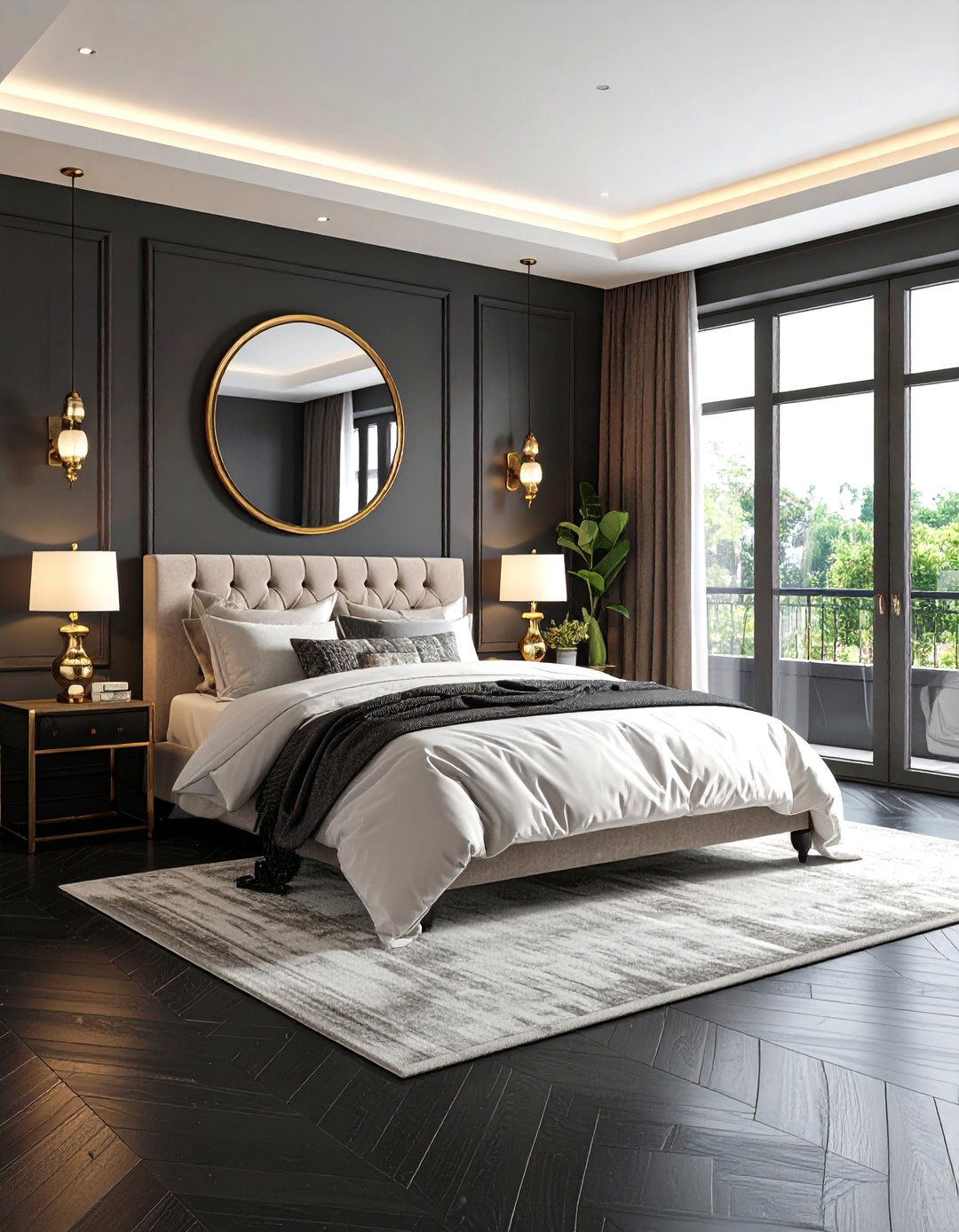
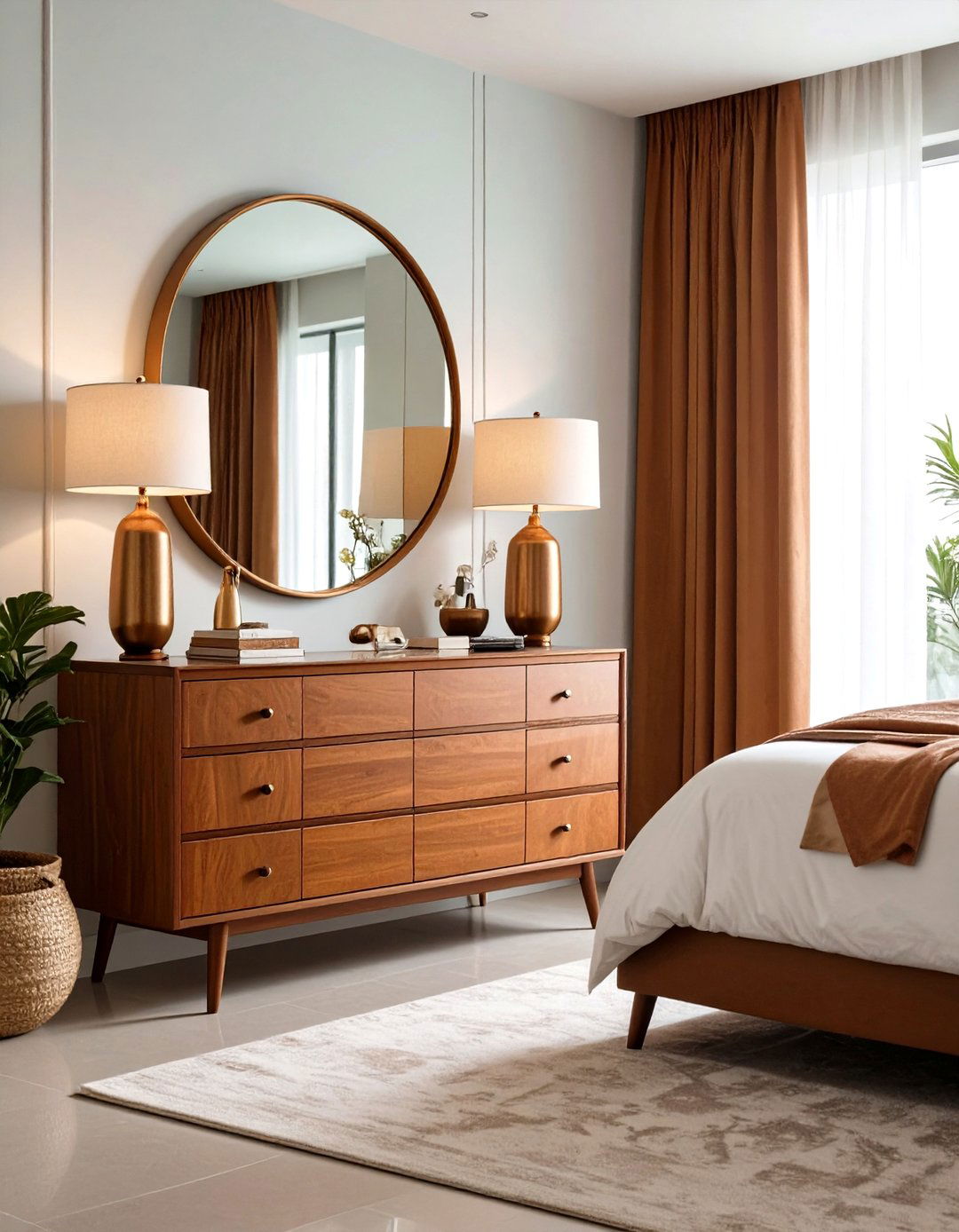
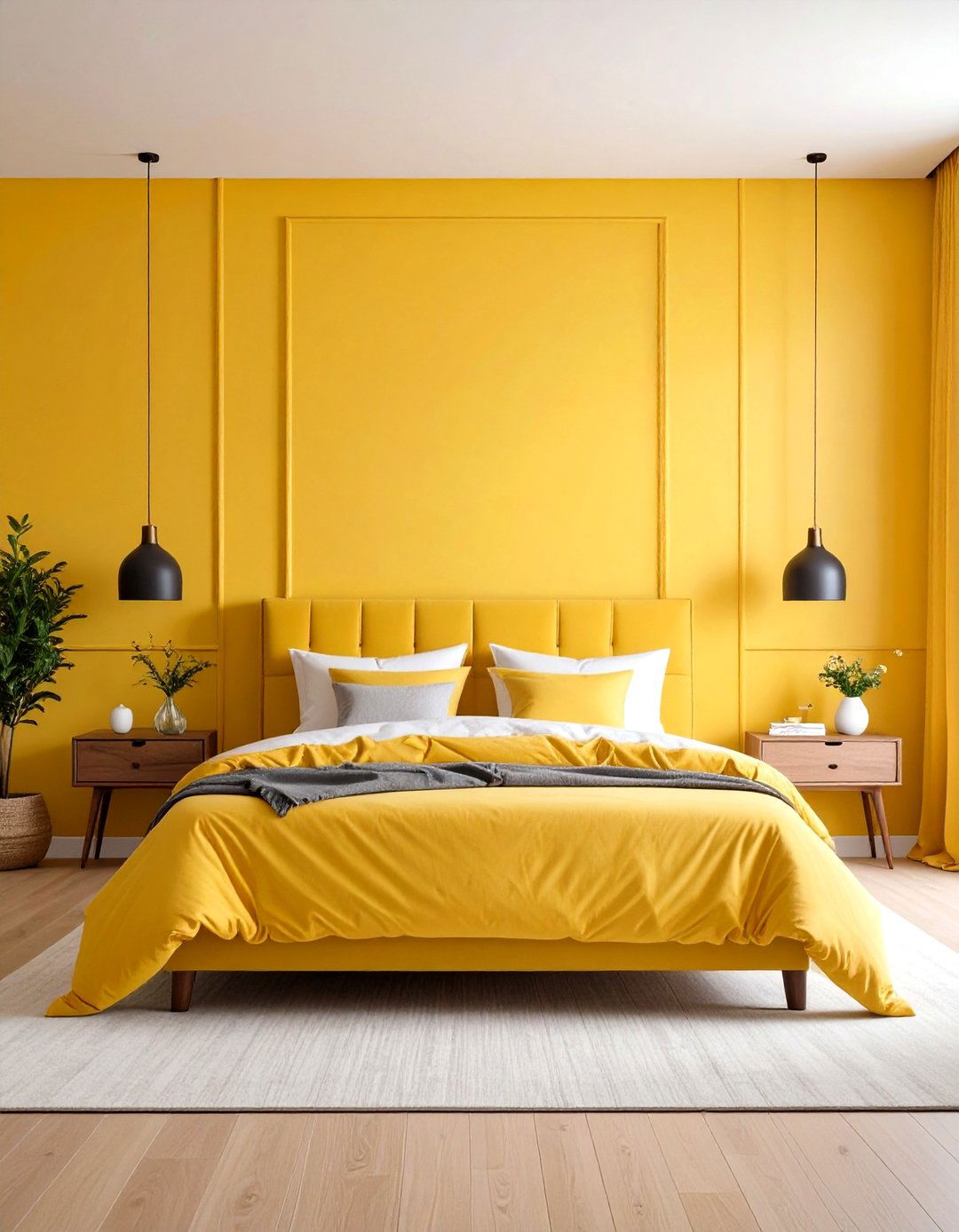

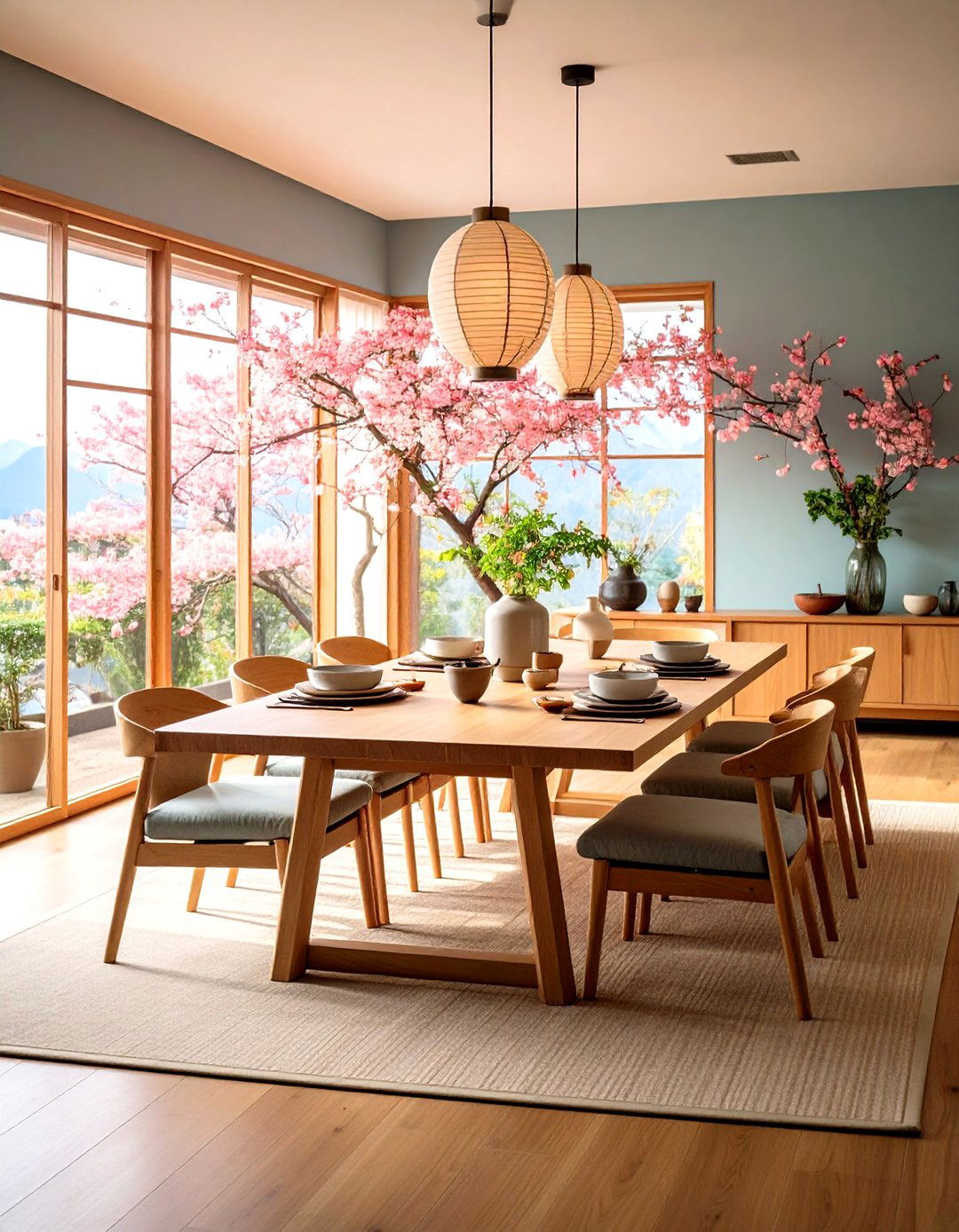
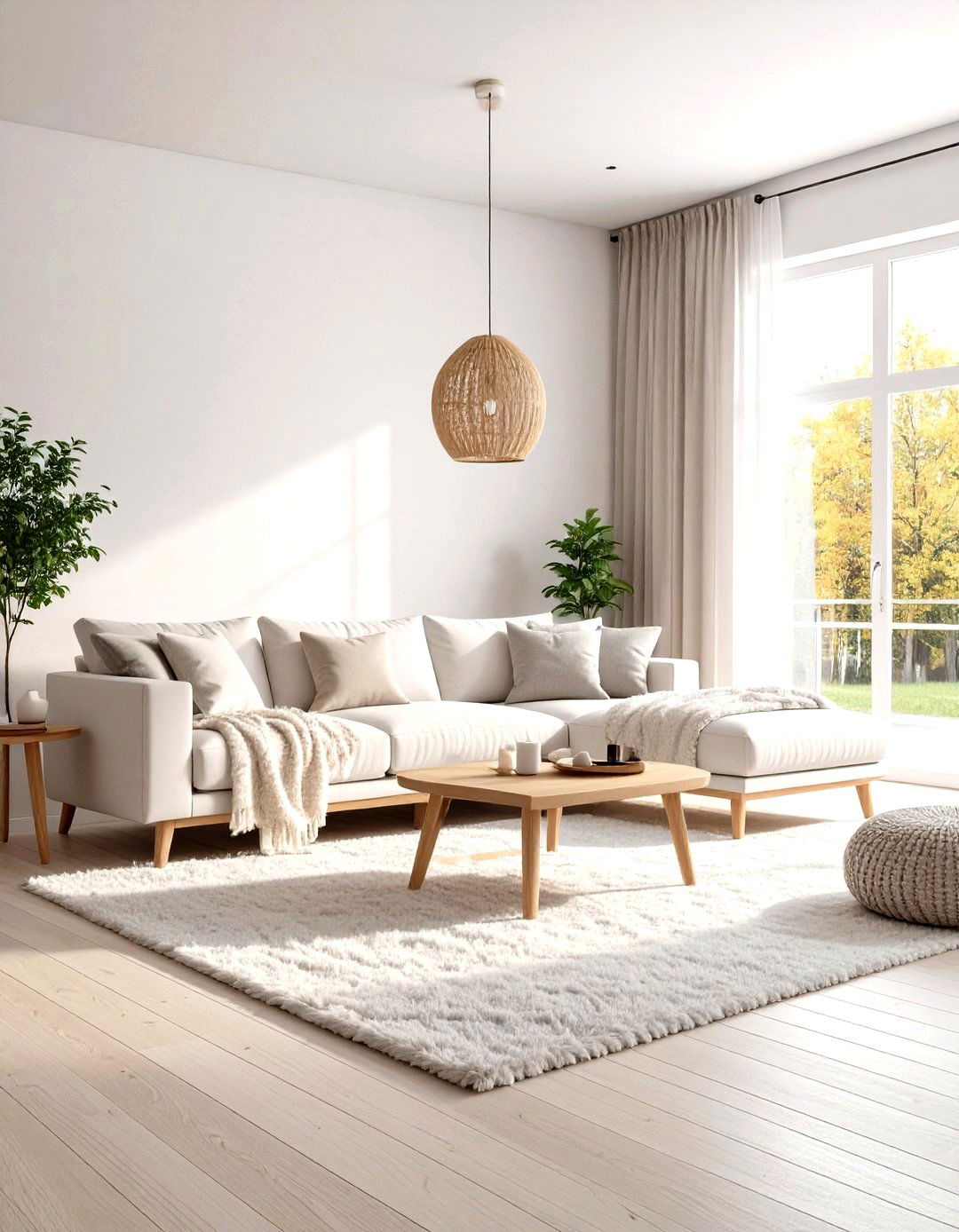
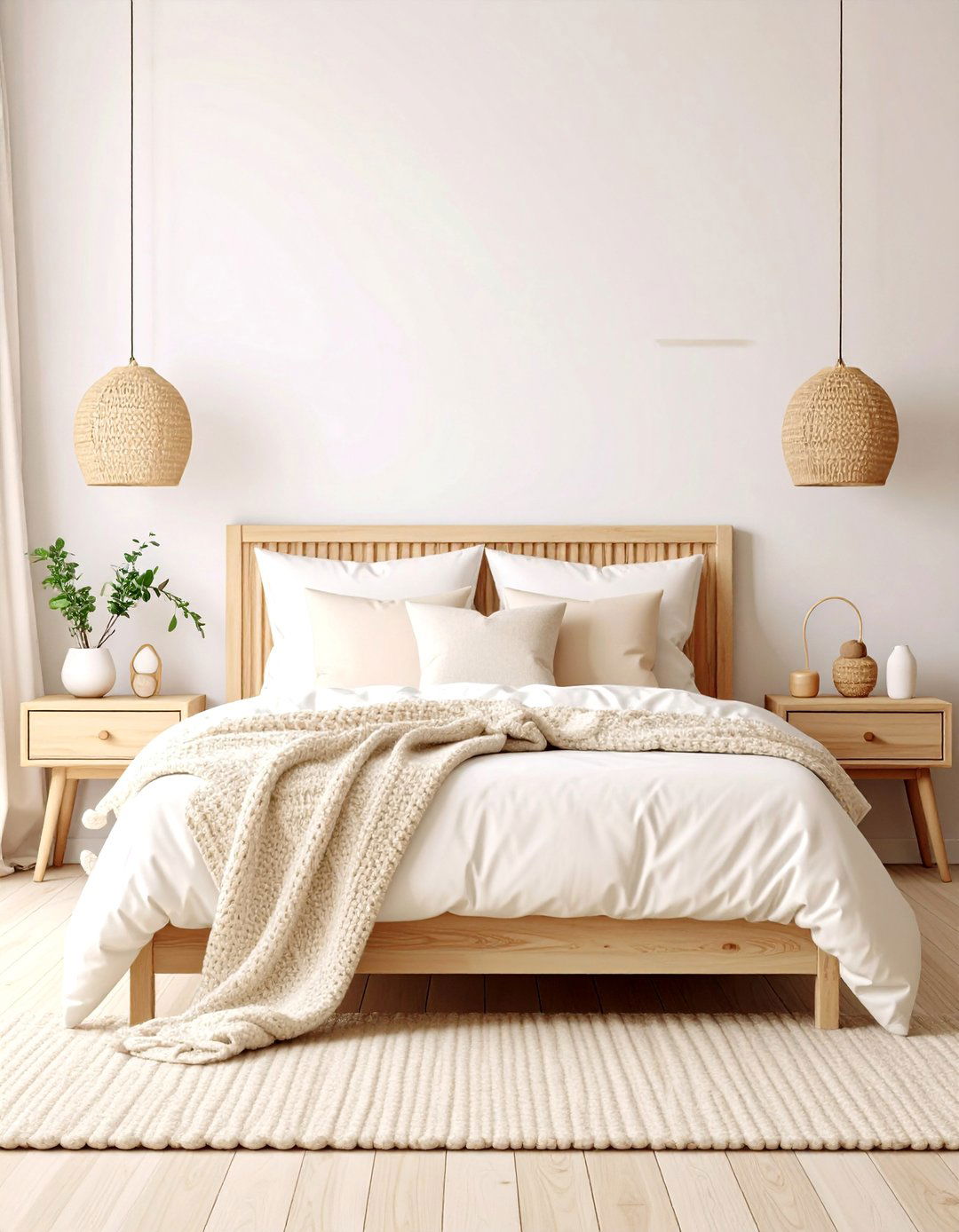
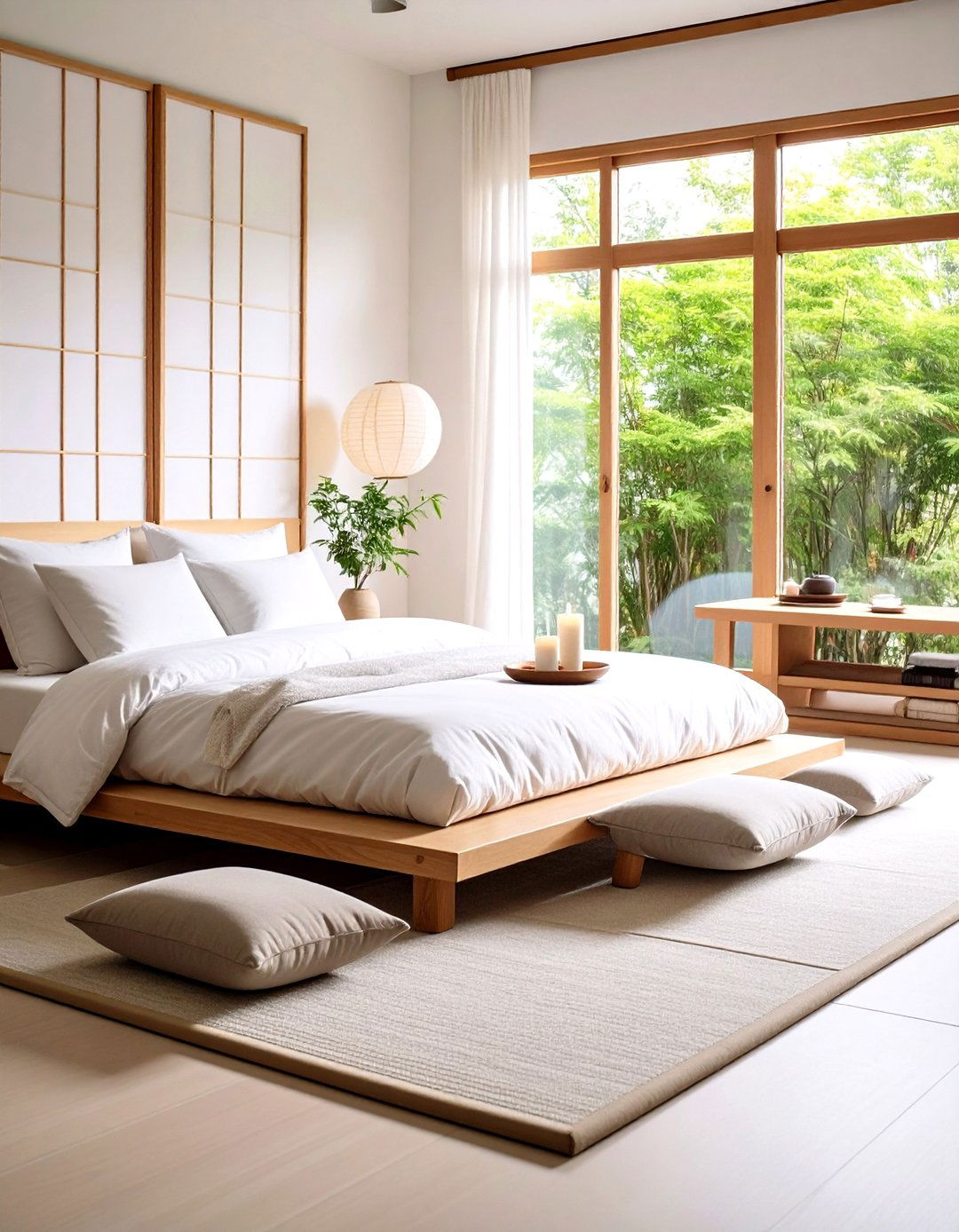

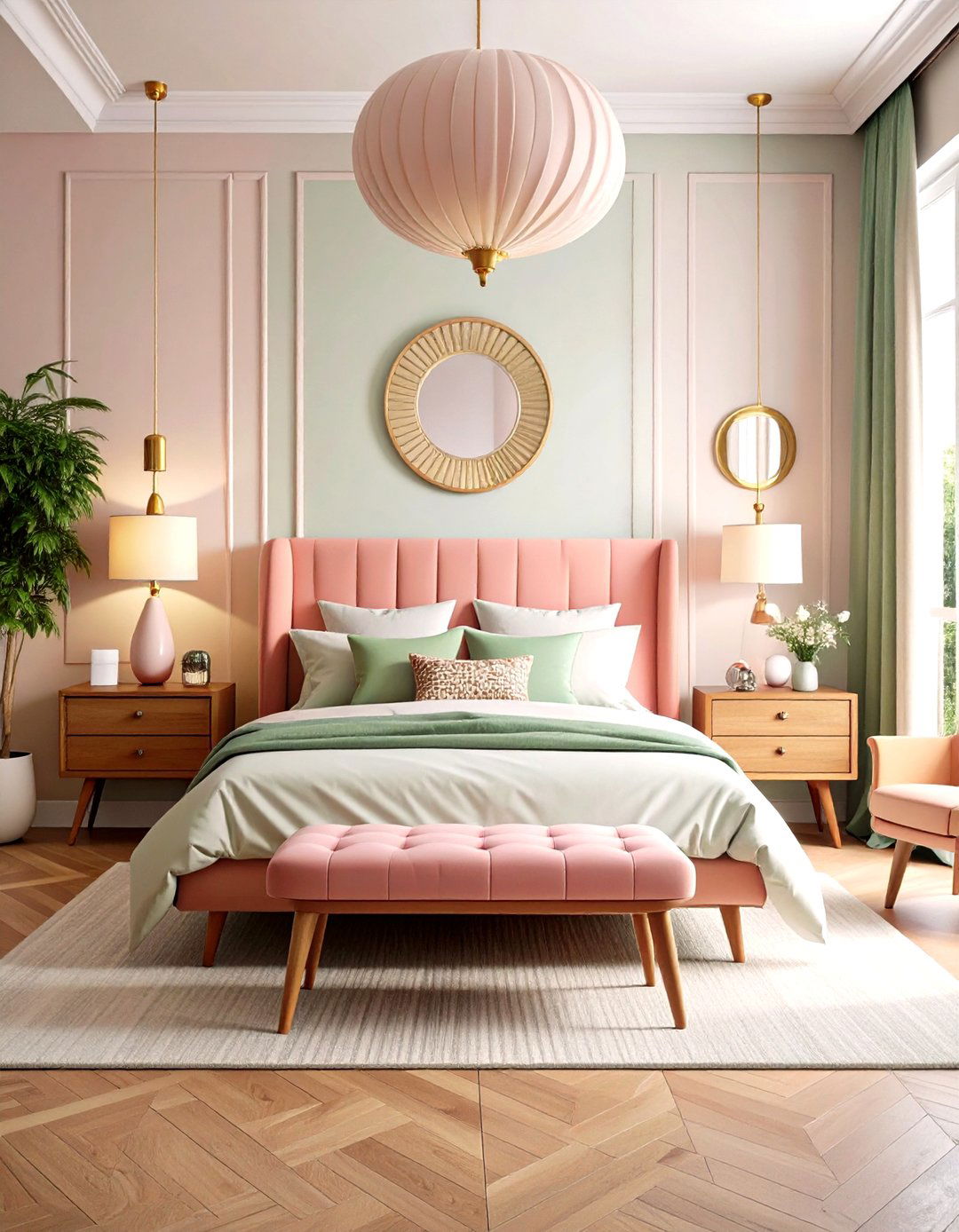
Leave a Reply